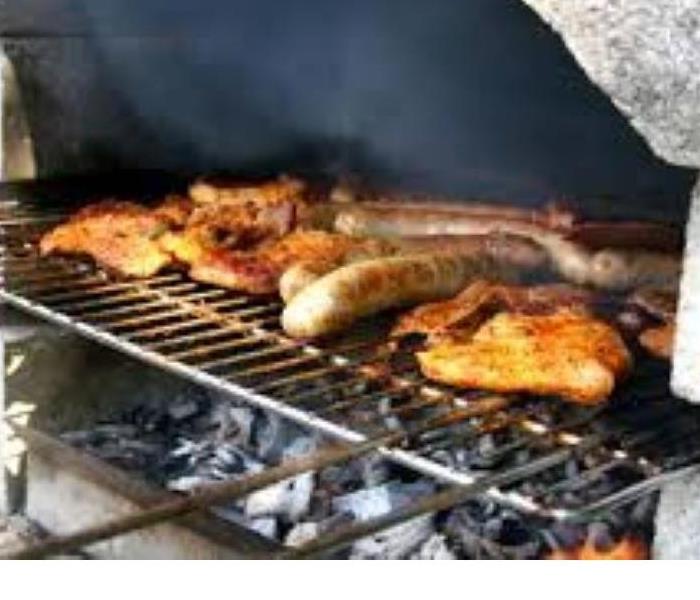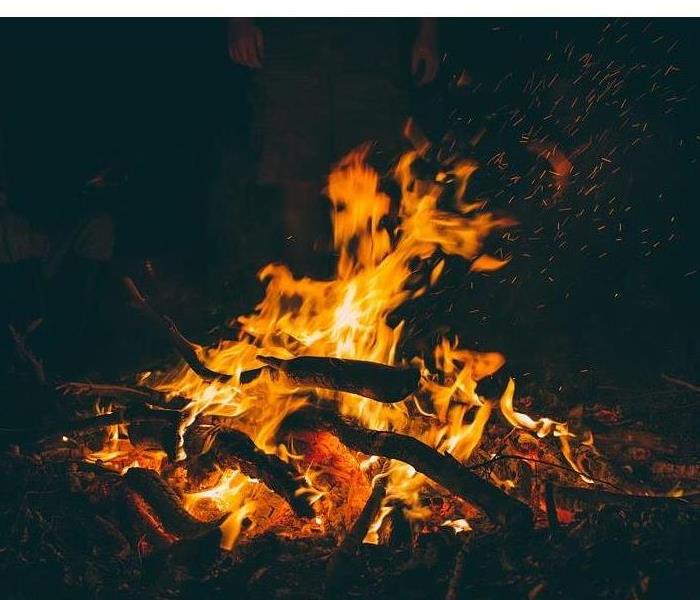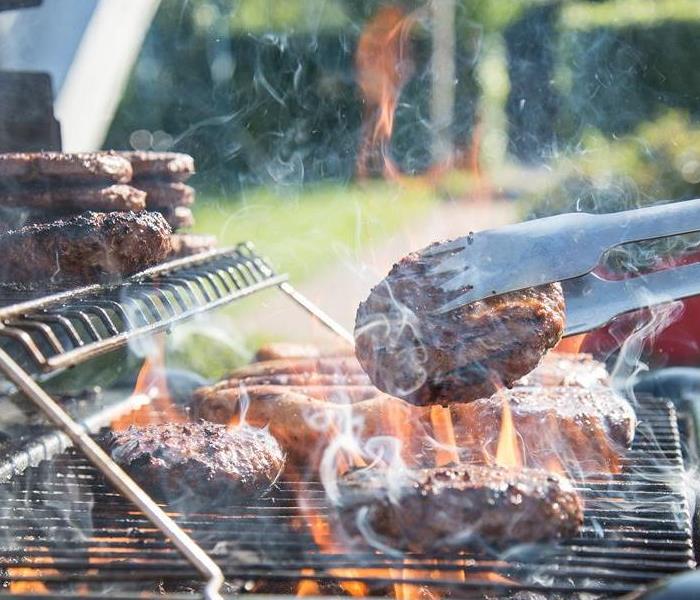Recent Fire Damage Posts
Understanding Smoke and Soot Damage: How SERVPRO of South San Rafael / Sausalito Can Help
8/20/2024 (Permalink)
When a fire strikes, the damage extends beyond the flames, leaving behind extensive smoke damage and soot damage. These elements can infiltrate every corner of your property, creating a pervasive odor and leaving stubborn residues. At SERVPRO of South San Rafael / Sausalito, we specialize in fire damage restoration and are available 24/7 to respond to any emergency, whether large or small.
There are different types of smoke that result in various forms of damage:
- Wet Smoke Damage: Typically caused by burning plastic and rubber, wet smoke is low-heat and smoldering. It leaves a sticky, smeary residue that’s tough to clean and produces a pungent odor. Wet smoke can also create smoke webs that are particularly difficult to remove.
- Dry Smoke Damage: Produced by fast-burning materials like paper and wood, dry smoke results in high temperatures that cause the smoke to rise. The residue left by dry smoke is easier to clean but can still cause significant fire damage if not addressed promptly.
- Protein Fire Residue: Unlike wet and dry smoke, protein fire residue is created through the evaporation of materials rather than direct combustion. This residue is virtually invisible but can discolor paints and varnishes, leaving an extremely pungent odor.
Before beginning any fire damage restoration, SERVPRO of South San Rafael / Sausalito conducts pretesting to identify the type of smoke damage. This allows us to tailor our cleaning procedures to the specific needs of your situation. Our equipment, expertise, and experience ensure effective restoration, treating your home with the utmost care.
If you’re dealing with fire damage, smoke damage, or soot damage, don’t hesitate to contact us. We’re here 24/7 to help you restore your property. Call us today at (415) 472-9198.
Next Steps After a Fire
5/2/2022 (Permalink)
FEMA recommends next steps after a fire:
-Contact your local disaster relief service, such as the American Red Cross. They will help you find food, clothing, medicine and a place to stay.
-If you have insurance, contact your insurance company. Ý Ask what you should do to keep your home safe until it is repaired. Ý Ask who you should talk to about cleaning up your home.
-If you are not insured, try contacting community groups for aid and assistance.
-Check with the fire department to make sure that your home is safe to enter. Be very careful when you go inside. Floors and walls may not be as safe as they look.
-Contact your landlord or mortgage company to report the fire.
-Try to find valuable documents and records. © If you leave your home, call the local police department to let them know the site will be vacant.
-Begin saving receipts for any money that you spend related to the fire loss. The receipts may be needed later by the insurance company and to prove any losses claimed on your income tax. © Check with an accountant or the IRS about special benefits for people recovering from fire loss
Steps After Smoke Damage
5/2/2022 (Permalink)
The first step after a fire is calling emergency services. Once the fire is out and you can enter your property, call your insurance company. They’ll assess what happened.
The next step is to find a reputable cleanup company that specializes in fire damage. Check for companies in your neighborhood that have a high customer satisfaction rating on sites like Google, Yelp, Angie’s List, or the Better Business Bureau. These specialized smoke damage mitigation companies clean and restore furniture, electronics, clothing, and textile items after they’re damaged by smoke or water.
Learn About fires
5/2/2022 (Permalink)
- Fire is FAST! In less than 30 seconds a small flame can turn into a major fire. It only takes minutes for thick black smoke to fill a house or for it to be engulfed in flames.
- Fire is HOT! Heat is more threatening than flames. Room temperatures in a fire can be 100 degrees at floor level and rise to 600 degrees at eye level. Inhaling this super-hot air will scorch your lungs and melt clothes to your skin.
- Fire is DARK! Fire starts bright, but quickly produces black smoke and complete darkness.
- Fire is DEADLY! Smoke and toxic gases kill more people than flames do. Fire produces poisonous gases that make you disoriented and drowsy.
Preparing a Fire Escape Plan
5/2/2022 (Permalink)
Some tips to consider when preparing this plan include:
- Find two ways to get out of each room in the event the primary way is blocked by fire or smoke.
- Make sure that windows are not stuck, screens can be taken out quickly and that security bars can be properly opened.
- Practice feeling your way out of the house in the dark or with your eyes closed.
- Teach children not to hide from firefighters.
- If you use a walker or wheelchair, check all exits to be sure you can get through the doorways.
Fire Damage
4/1/2022 (Permalink)
SERVPRO of S. San Rafael/Sausalito is all too familiar with fires; we specialize in returning your property to its original form making it "Like it never even happened." . Aside from the fire itself, smoke and soot are nearly impossible to completely get rid of the smell. SERVPRO has the ability through industry-leading equipment and technology stream mediate your smoke damage property right the first time. Each fire situation is unique, we tailor and treat your loss the same as any other loss. Depending on the scope of the damages, it is important to speak with your insurance agent about provisions available.
Please call us at (415)479-2900
SERVPRO Fire Restoration Services
11/18/2021 (Permalink)
SERVPRO of S. San Rafael/Sausalito is experienced in fire mitigation to remediate your damages "Like it never even happened." Pack-outs are a vital component in the mitigation process as it allows for our team of highly trained technicians to restore your valuable belongs ratherthan relacing . While most mitigation work can happen on-site, SERVPRO of S. San Rafael/Sausalito has the ability to take your precious belongings offsite, where we focus on specialized attention in cleaning each item, to restore it to its original form. Once your items have entered our facility, we assess the damages and choose which remediation approach. Disaster is unique, so our trained remediation technicians use a multitude of approaches such as ozone chamber, ultrasonic cleaning tank and many other methods.
Please call us at (415)479-2900
Top Causes of Fires in Your San Rafael Home
10/1/2021 (Permalink)
An accidental fire can spread uncontrollably in seconds and destroy property in minutes. House fires put everyone in danger, even tiny fires that are quickly extinguished can make your pockets hurt. Having the right insurance coverage in place can help lessen the financial burden caused by a house fire, but it's far preferable to avoid the situations that cause fires in the first place.
SERVPRO of S. San Rafael/Sausalito can help with cleanup and content storage after a fire in your home or business. We are available 24 hours a day, 365 days a year, to assist with any-sized disaster. The NFPA has listed the top five causes of house fires and how to prevent them.
#1: Cooking Related Fires
The most common cause of a house fire is a cooking accident. But, according to the National Fire Protection Association, unsupervised cooking is the most significant cause of home fires. Home fires are frequently caused by grease that overheats on a stove or oven. This is because grease is highly combustible, and when it reaches a particular temperature, it spontaneously combusts. Unfortunately, once the oil has ignited, putting it out can be a difficult task. So, when you're cooking, stay in the kitchen.
#2: Heating Appliances
The use of HVAC systems increases dramatically during the winter months. Heating appliances are the second greatest cause of home fires. If curtains, clothes, blankets, fabrics, and furniture touch space heaters or baseboard heaters, they might spark a fire. Keep portable heaters at least three feet away from anything that could catch fire and avoid using them to dry shoes or garments.
#3: Electrical Fires
Faulty wiring is one risk that many homeowners ignore. Short circuits and overloading are standard in older electrical systems. The majority of modern, professionally installed electrical systems are safe and contain built-in safety mechanisms. It's a good idea to have your wiring checked out by a professional electrician, especially if you live in an older home. Never attempt electrical repairs or improvements unless you are familiar with the principles of electricity and have prior experience doing so.
#4: Smoking
When you smoke in your home, cigarette butts can create fires if they fall on carpeting, furniture, or other flammable materials. It's better to keep smoking out of the bedroom since a butt can be lit for hours. If you need to smoke, do so outside, or smoke over a sink with an ashtray to lessen the fire risk.
#5: Candles
In the United States, candles are another significant source of house fires. Most candle-related home fires are caused by negligence. It is never a good idea to leave a candle unattended. Candles powered by electricity or batteries can also help reduce the danger of house fires caused by candles.
If your home or business has been affected by smoke or fire damage, SERVPRO of S. San Rafael/Sausalito has the equipment, expertise, and experience to restore your property. We will also treat your family with empathy and respect and your property with care. Give us a call at (415) 479-2900, and we can start making it "Like it never even happened."
Prevent Smoke Odors from Invading Your Home
8/4/2021 (Permalink)
The bottom line is it’s difficult to get rid of smoke odor in a home after a fire. To eliminate smoke odors, the cleanup process must incorporate specific equipment and techniques that can only be provided by a professional restoration company. As a result, we don’t recommend people take on this project on their own. Look at the stages involved in repairing smoke damage.
The types of smoke odor
Smoke is made up of persistent particles (soot), oils, and gases that arise from incomplete combustion. The unpleasant smoke odor is caused by volatile molecules released by burning things.
Burning protein (meat), natural materials (wood, cotton, etc.), synthetic materials (e.g., plastic, nylon) and other substances can produce smoke odor.
How to remove smoke smell from properties
The most crucial step in removing smoke odor is to eliminate the source of the odor(s). Burned items, such as cabinets, furniture, walls, and non-salvageable contents, must be removed. Depending on their condition, the goods can be tossed or restored.
Cleaning the salvageable contents
Technicians use proper cleaning materials to clean the salvageable artifacts. Exterior surfaces such as walls, windows, and decks are pressure washed, scrubbed, and disinfected. Interior walls and hard surfaces can be easily cleaned with mild soap and water, then thoroughly rinsed. Cleaning inside cabinets, drawers, and closets, as well as washing household objects, will be done by professionals.
Cleaning the air ducts
A fire’s smoke, soot, and odors will permeate the duct system, as well as any dust or particles within it. As a result, cleaning the ducts early in the smoke odor removal process is critical to avoid the HVAC system recontamination of previously cleaned areas. Ductwork cleaning should only be done by professionals, as it calls for the use of specific equipment and processes.
Removing the smoke smell
The final stage is removing the lingering airborne odor. SERVPRO Professionals are trained to identify and eliminate offensive odors with industrial air scrubbers and fogging equipment. This equipment can effectively treat serious and persistent odors that typical air fresheners and similar treatments can’t.
- Air scrubbers remove airborne particles and contaminants.
- Thermal foggers and deodorization agents control odors.
SERVPRO of S. San Rafael/Sausalito has the training and equipment to identify and eliminate harmful smoke odors. By identifying the cause of the odor and determining the conditions in which it contacts any surfaces, the odor can often be removed without a trace. The science of identifying and eliminating odors can be a tricky thing, so give SERVPRO of S. San Rafael/Sausalito a call and leave the restoration to us.
How Do I Restore My San Rafael Home After a Grease Fire?
8/4/2021 (Permalink)
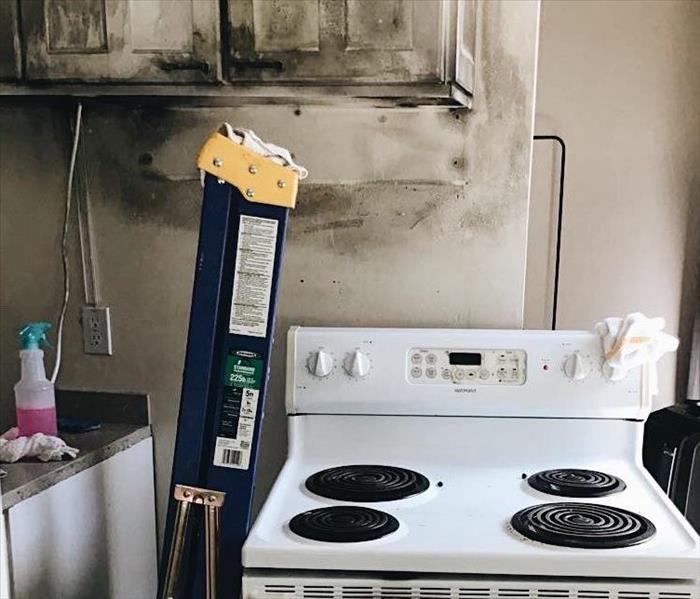 This San Rafael home had a grease fire, which caused smoke damage to the entire unit and needed heavy cleaning to walls, floors, and ceilings.
This San Rafael home had a grease fire, which caused smoke damage to the entire unit and needed heavy cleaning to walls, floors, and ceilings.
Watch What You Heat In Your San Rafael Home
Cooking can be a calming but dealing with a cooking fire is always a stressful experience. However, SERVPRO of S. San Rafael/Sausalito is here to help offer steps to take during and after a grease fire. When dealing with a grease fire stay calm and remember these dos and don’ts for dealing with this kind of event.
- Don’t use water to extinguish a grease fire.
Pouring water on a grease fire, unlike most other flames, will exacerbate the situation. Water, rather than extinguishing the flame, will distribute the burning oil, spreading the fire.
- Don’t use flour or sugar to extinguish grease fires.
Flour and sugar are also flammable, thus throwing them on a grease fire will simply add to the fire’s intensity.
- Don’t Use a Water-Based Extinguisher
A fire extinguisher is required in every kitchen, but not just any extinguisher will suffice. Pouring water on a grease fire has the same negative results as a water-based fire extinguisher.
- Don’t Take the Fire Outside with You
It is extremely risky to carry a pan with a grease fire outside. The hot grease could spill, causing injury to the carrier or spreading the fire to other parts of the house.
When confronted with a grease fire, what should you do?
- Turn off the stove
Switch off the stove right away. Turn off your main gas or power source if the controls are unreachable due to flames.
- Use a Metal Lid
A lid placed over a flaming pan will deprive it of oxygen, thereby extinguishing the fire. If you don’t have a metal cover, a metal baking sheet will do. If the lid doesn’t entirely cover the flames, the oxygen may still be available. To ensure the flames have extinguished, leave the lid on for at least a few minutes. Lids made of glass or plastic are not suited for putting out a grease fire.
- Apply Salt or Baking Soda to Extinguish the Flames
A flame can be smothered by pouring salt or baking soda on it. Depending on the size of the flame, the amount of baking soda or salt required will vary. Baking soda should not be substituted with baking powder or flour.
- Grab a Class B Flame Extinguisher
A grease fire is best put out with a class B dry fire extinguisher. Stand back when using the extinguisher to avoid getting burned by the hot grease or flames.
When Do You Call in a Professional?
Go outdoors and call the fire department if baking soda or a class B extinguisher fails to work. Call a water and fire damage restoration company to begin the clean-up process once the fire is out and the fire department have given you permission to enter the building.
SERVPRO of S. San Rafael/Sausalito can assist you in getting back to clean, whether you have a huge fire or an odor that won’t go away after a burning dinner. Give us a call today at (415) 479-2900.
Smoke Detector Going Off for No Reason? Here's Why
8/4/2021 (Permalink)
Smoke alarms are critical for keeping you and your family safe in the event of a fire in your home. However, they don’t always go off when a real fire threatens to erupt in your home. Even though false alarms are standard, you shouldn’t dismiss the sound if you don’t see or smell smoke. Before you can, smoke detectors can detect fires that are not visible to the naked eye, such as electrical fires. Here are the leading reasons for smoke detector false alarms to help you better understand how they work.
Reasons Why Your Smoke & Fire Alarm Keep Going Off
- Burnt Food on Stovetop
If you don’t keep an eye on the stove while you’re cooking, your meal may emit smoke, which will set off the smoke alarm. In other circumstances, smoke isn’t required; a whiff of cooked food can trigger the detector. Also, make sure your smoke alarm is in the hallway leading to the kitchen rather than in the kitchen itself.
- Smoke Detector Placement
It only takes a small amount of smoke to set off the alarm. If your smoke detector is within 10 feet of a cooking appliance like a stove, toaster, or toaster oven, it may be setting off false alarms.
- Steam or a High Humidity Environment
High humidity might cause thick moisture particles to be mistaken for smoke by your smoke detector. Steam follows the same logic. If your smoke detector is located directly outside a steamy bathroom, you may want to relocate it.
- Insects
Because small bugs like to hide in dark crevices, they may creep into your smoke detectors, causing a false alarm. If you’re unsure why an alarm went off, open the device, and look for small insects. If insects are to blame, use pest control sprays near your smoke alarms.
- Dust Collecting
A buildup of dust might potentially cause your smoke alarm to malfunction. So, it’s suggested that you clean your smoke detectors with a vacuum brush attachment at least once a year, if not more frequently.
- Chemical Odors
Smoke detectors are also sensitive to particles in the air generated by chemicals with a strong odor. This could be the cause of your false alarms if you’re remodeling your home, deep cleaning, or utilizing powerful chemicals for another reason.
- Low Battery Power
Smoke alarms generally emit little chirping noises when their batteries are low or aren’t adequately attached. While this isn’t the sound of smoke detection, it is a signal that you should check your device. Replace batteries twice a year, at the beginning and end of daylight savings time.
If there is heavy soot damage to the property, the smoke detector might not give an alarm. Professional Disaster restoration professionals will have to deal with the fire and smoke damage. SERVPRO of S. San Rafael/Sausalito can help with this. Please find out more about our fire damage restoration services by contacting us today for any of your restoration needs.
Cleaning Up Smoke Damage After a House Fire in Your San Rafael Home
5/5/2021 (Permalink)
Tips For Smoke Damage in Your San Rafael Home
Smoke damage cleanup after a house fire may seem like a breeze, but cleaning smoke damage can be much more complicated than most think. The stubborn smell that smoke leaves in its wake on different surfaces found throughout the house is very tough to remove altogether. SERVPRO of S. San Rafael/Sausalito has vast experience in this process and offers methods to clean up smoke damage following a house fire.
Smoke Damage Cleaning Tips
After a house fire, especially in warmer temperatures, the odor left by the fire doesn’t go altogether. It is common to believe that aerosols, air fresheners, and perfumes get the job done. They only serve to dilute the odor and are not capable of cleaning it thoroughly. Before beginning the smoke damage cleanup and restoration process, stop spreading soot by turning off the A/C and opening all the doors and windows to allow clean air to run throughout the entire house. Setting up an air purifier to run throughout the clean-up can protect you from inhaling harmful fumes.
If you have not already reached out to your local fire cleanup company, like SERVPRO of S. San Rafael/Sausalito, give us a call at (415) 479-2900 and set up an appointment to address your needs. A good fire restoration company should have well-trained and IICRC-certified technicians that have a great deal of experience and can save you more time and money than doing it yourself.
Tips on Smoke Damage Cleanup
First, go through the house and lightly remove and vacuum any loose soot remaining after the house fire. Next, you will need a dry-cleaning sponge (chemical sponge) for any walls and other hard surfaces. This is a vital part of the cleanup process because the special chemicals within the sponge can remove the heavy smoke and soot stains from walls and other hard surfaces. Using single strokes in one direction, gently wipe the surface with a clean side of the sponge. When the sponge side is stained after use, you can use scissors to cut off a segment of the sponge to make it look brand new. Remember to not use water or soot cleaner before using the sponge because that only serves to spread the soot around and won’t allow you to utilize the chemicals in the sponge. White vinegar for fire damage cleanup is a very effective solvent. SERVPRO advises you to place bowls of white vinegar in all rooms that the fire affected.
The next step is to add 1 to 3 tablespoons of a mild degreaser or dish soap to a gallon of water and use the same cleaning strategy as the cleaning sponge to wipe down all the affected hard surfaces. It might be necessary to repeat these cleaning steps a large fire produced a lot of smoke. Continually rinse the rag or sponge so that you do not enable the spread of soot and smoke damage. Additionally, use a new bucket of the solution once it appears darker in color. Then repeat the process with just a clean cloth soaked in solely pure water.
After completing all these steps correctly, there are instances where the odorous smell persists. This calls for using an ozone generator, which is available to rent, buy, or borrow, which is very effective in removing the odor left behind after a fire in your home. To make this process run smoothly, it might be more beneficial to have a fire restoration company provide ozone generators to complete this process for you.
Call the Smoke Damage Cleanup Experts
Cleaning up after a house fire can be a daunting task, requiring an immediate response. Do not let immobility, lack of experience, or a busy schedule prevent you from restoring your home. Fire-damaged homes require extensive cleanup and need to be treated immediately. SERVPRO of S. San Rafael/Sausalito can help you do it all with their state-of-the-art equipment and advanced techniques; we get it done right the first time. Our highly skilled techs are sympathetic to the tragedy of a house fire and understand that communicating effectively with you is so important. We also work with your insurance company.
Why Do I Need a Professional to Handle Fire Restoration?
5/5/2021 (Permalink)
Was your home recently damaged in a fire? DIY fire restoration may seem tempting to save a little cash in the recovery, but the bottom line is that fire and smoke restoration is jobs for the professionals. Here are four reasons why trying to fix the chaos yourself could be troublesome.
You Might Be Exposed to Hidden Health Effects
The harsh reality of a fire is that the hazards don’t go away after the flames go out. The smoke and soot residue left behind hold more weight than merely a reminder of a disaster. Soot exposure to fire-damaged objects and lingering residue can cause health effects. Soot exposure in a fire-damaged home is the highest during the cleanup process. Unless a thorough cleaning is performed, the adverse health effects of smoke can stick around for years. For that reason, you should bring in fire restoration professionals to complete the job with deep-cleaning techniques to restore your home to its pre-fire condition.
Special Equipment is Required
A dust mask and degreaser are not nearly enough to properly clean up fire and smoke damage. Surfaces must be deep cleaned to eliminate potential health effects and remove lingering odors. Professional equipment and proper cleaning techniques ensure a safe and thorough fire restoration process.
You Could Mistakenly Throw Away Salvageable Goods
After a fire, it may seem simple to toss belongings that many deem a lost cause. Yet, with advanced recovery techniques, a fire restoration professional can help to minimize your loss. Nonetheless, for contaminated items that genuinely are unsalvageable, proper disposal of such things helps to reduce fire hazards.
The Recovery Process Could Take Much Longer
It is not a complicated task to restore your home to its pre-fire condition. There are belongings to salvage, cleanup to complete, and the home’s structure to restore. The entire process is too much of a burden to carry alone. Your efforts to save money by taking fire restoration head-on yourself can easily backfire. Time is of the essence with fire damage, and if done yourself, can cause a domino effect. Working with a fire restoration company that is well versed in the disaster recovery process is a much more suitable option.
Schedule Professional Fire Restoration Services
The team at SERVPRO of S. San Rafael/Sausalito is here to deliver affordable, convenient fire and smoke damage restoration services. We make the recovery process as quick and painless as possible. Contact us today to learn more about our fire restoration services.
Got Smoke or Soot Damage? Call Us Today (415) 479-2900
Fire or Water Damage? We Can Handle It!
5/4/2021 (Permalink)
At SERVPRO of S. San Rafael/Sausalito provides 24-hour emergency service and is dedicated to being faster to any-sized disaster in S. San Rafael/Sausalito and surrounding cities! We can respond immediately to your emergency and have the expertise to handle your restoration or cleaning needs.
- 24-Hour Emergency Service
- Faster to Any-Sized Disaster
- Highly Trained Restoration Technicians
- A Trusted Leader in the Restoration Industry
- Locally Owned and Operated
- Advanced Restoration and Cleaning Equipment
Have Questions? Call Us Today – (415) 479-2900
Residential Services
Whether your San Rafael/Sausalito home needs emergency Fire Damage, Flood Damage or your upholstery cleaned, you can depend on us. Our technicians have extensive cleaning and restoration training and can make your property look its best. Learn more about our residential services:
- Water Damage Restoration
- Fire Damage Restoration
- Mold Remediation
- Storm Damage Restoration
- Cleaning Services
- Building/Reconstruction Services
Commercial Services
There's never a convenient time for fire or Water damage to strike your San Rafael/Sausalito commercial property. Every hour spent cleaning up is an hour of lost revenue and productivity. So when the need arises for fast professional cleaning or emergency restoration services we has the training and expertise to respond promptly with highly trained technicians to get your property back to business. Learn more about our commercial services:
- Commercial Water Damage Restoration
- Commercial Fire Damage Restoration
Smoke and Soot Cleanup
5/4/2021 (Permalink)
Smoke and soot is very invasive and can penetrate various cavities within your home, causing hidden damage and odor. Our smoke damage expertise and experience allows us to inspect and accurately assess the extent of the damage to develop a comprehensive plan of action.
Smoke and soot facts:
- Hot smoke migrates to cooler areas and upper levels of a structure.
- Smoke flows around plumbing systems, seeping through the holes used by pipes to go from floor to floor.
- The type of smoke may greatly affect the restoration process.
Different Types of Smoke
There are two different types of smoke–wet and dry. As a result, there are different types of soot residue after a fire. Before restoration begins, SERVPRO of South San Rafael / Sausalito will test the soot to determine which type of smoke damage occurred. The cleaning procedures will then be based on the information identified during pretesting. Here is some additional information:
Wet Smoke – Plastic and Rubber
- Low heat, smoldering, pungent odor, sticky, smeary. Smoke webs are more difficult to clean.
Dry Smoke – Paper and Wood
- Fast burning, high temperatures, heat rises therefore smoke rises.
Protein Fire Residue – Produced by evaporation of material rather than from a fire
- Virtually invisible, discolors paints and varnishes, extreme pungent odor.
Our Fire Damage Restoration Services
Since each smoke and fire damage situation is a little different, each one requires a unique solution tailored for the specific conditions. We have the equipment, expertise, and experience to restore your fire and smoke damage. We will also treat your family with empathy and respect and your property with care.
Have Questions about Fire, Smoke, or Soot Damage?
Call Us Today – (415) 479-2900
Fire or Water Damage? We can handle It
11/19/2020 (Permalink)
SERVPRO of S. San Rafael/Sausalito provides 24-hour emergency service and is dedicated to being faster to any-sized disaster in S. San Rafael/Sausalito and surrounding cities! We can respond immediately to your emergency and have the expertise to handle your restoration or cleaning needs.
- 24-Hour Emergency Service
- Faster to Any-Sized Disaster
- Highly Trained Restoration Technicians
- A Trusted Leader in the Restoration Industry
- Locally Owned and Operated
- Advanced Restoration and Cleaning Equipment
Have Questions? Call Us Today – (415) 479-2900
Residential Services
Whether your San Rafael/Sausalito home needs emergency Fire Damage, Flood Damage or your upholstery cleaned, you can depend on us. Our technicians have extensive cleaning and restoration training and can make your property look its best. Learn more about our residential services:
- Water Damage Restoration
- Fire Damage Restoration
- Mold Remediation
- Storm Damage Restoration
- Cleaning Services
- Building/Reconstruction Services
Commercial Services
There's never a convenient time for fire or Water damage to strike your San Rafael/Sausalito commercial property. Every hour spent cleaning up is an hour of lost revenue and productivity. So when the need arises for fast professional cleaning or emergency restoration services we has the training and expertise to respond promptly with highly trained technicians to get your property back to business. Learn more about our commercial services:
- Commercial Water Damage Restoration
- Commercial Fire Damage Restoration
Safety Tips for your Fire Escape Plan
10/19/2020 (Permalink)
October is Fire Prevention Month and our team at SERVPRO San Rafael/Sausalito have followed these safety tips shared by the National Fire Protection Association through this year’s National Fire Prevention Week campaign, “Not Every Hero Wears a Cape. Plan and Practice Your Escape!”
Please be safe and follow these tips so that you and your family can escape the fire safely.
- It is important to know the layout of your home. Make an escape plan by drawing a map that shows all your windows and doors, which could potentially be your exit strategy.
Fact: One-third of American households who made an estimate thought they would have at least 6 minutes before a fire becomes life threatening. Unfortunately, the time available could be as little as one to two minutes, according to Lorraine Carli, NFPA’s vice president of Outreach and Advocacy.
- Know at least two ways out of every room, if possible. Make sure all doors and windows leading outside can be easily opened.
Fact: A closed door may slow the spread of smoke, heat, and fire. Make sure to close all doors behind you when exiting a room. Also, check to make sure a door is not hot, that can be an indicator of a fire on the other side.
- Have an outside meeting place (like a tree, light pole or mailbox) a safe distance from the home where everyone should meet.
Fact: Escape planning and practice can help reduce the time to get everyone out. It is best to call the Fire Department when outside your home.
- Practice your escape plan during the day and night with everyone in your home at least twice a year using different ways out. Be extra mindful to teach children how to escape on their own in case you can’t help them.
Fact: While 71% of Americans have an escape plan in case of a fire, only 47% of those have practiced it.
- If the smoke alarm sounds, your first thought should be to get out. Never go back inside for people or pets.
Fact: Only 8% said that their first thought on hearing a smoke alarm would be to get out. Smoke inhalation is also very dangerous. If you need to go through smoke, get low and go under the smoke till you reach your way out.
For more information or resources regarding fire, electrical, or related hazards, please feel free to visit the National Fire Protection Association at https://www.nfpa.org/.
Wildfire Prevention and Healthy Tips
8/21/2020 (Permalink)
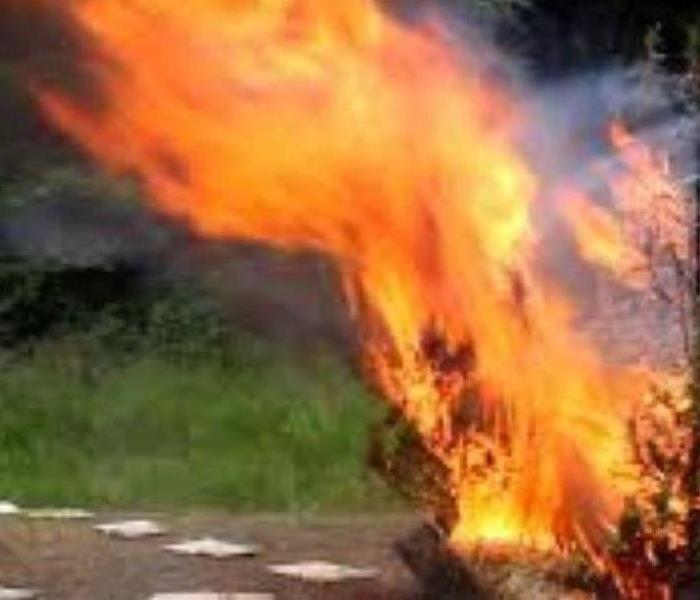 Vegetation fire next to the road
Vegetation fire next to the road
Wildfires can occur at anytime and anywhere throughout the year. Late summer and early fall is typically the peak time for wildfires in California. People that live or work in an area prone to wildfires are at greater risk. Wildfires sometimes start naturally by heat ignited from sun light or lightning strikes. However, majority of the wildfires in the U.S. are caused by humans. Some human-caused fires result from campfires left unattended, negligently discarded cigarettes or intentional acts of arson. A wildfire can move as fast as 6.5 miles per hour in forest and 14 miles an hour in grassland, consuming trees, homes, natural resources, humans and everything in its path.
By working together, we can make our residents and neighborhood safer from wildfires by taking safety precautions. Here are some wildfire safety tips to help prevent wildfire from occurring.
Wildfire Safety Tips
- Clear leaves and other debris from gutters, eaves, porches and decks. Remove dead vegetation from under your deck and within 10 feet of the house. This prevents embers from igniting your home.
- Remove anything stored underneath decks or porches. Screen or box-in areas below patios and decks with wire mesh to prevent debris from accumulating.
- Ensure flammable materials (firewood stacks, propane tanks, dry vegetation) are more than 30 feet from your home or business's foundation and outbuildings.
- Wildfire can spread to tree tops. If you have trees on your property, prune so the lowest branches are 6 to 10 feet from the ground.
- Keep your lawn hydrated and maintained. If it is brown, cut it down to reduce fire intensity. Dry grass and shrubs are fuel for wildfire.
- Inspect shingles or roof tiles. Replace or repair shingles that are loose or missing to prevent ember penetration.
- Cover exterior attic vents with metal wire mesh no larger than 1/8 inch to prevent sparks from entering the home.
- Enclose eaves and screen soffit vents using 1/8 mesh metal screening to prevent ember entry.
SERVPRO of S. San Rafael/Sausalito specializes in fire and water damage restoration. We have the specific damage restoration training, personnel, and equipment and can quickly restore your home to pre-fire condition. Call us today 415-479-2900.
Summer Fire Safety, BBQ Preparation
8/5/2020 (Permalink)
The sun is out and it's time to barbecue, whether you plan to resurrect your old BBQ from the shed or purchase a shiny new one. However, it is important to remember the risk that fire can pose; so before you start grilling, take note of this important BBQ fire safety advice.
Fire Safety is Key
Before you even light the flames on your BBQ you need to think about a number of factors. Where are you going to place it? Which fuel are you using (natural gas, charcoal or propane)? How will you extinguish the flames in an emergency?
Where you place your BBQ is really important. Ideally it has to be in a clear space, with no overhanging branches or nearby debris which could potentially catch fire. You should also try and place it out of the wind so there's no danger of flames being blown on to the chef. It's also key to ensure that the unit is on solid ground with no risk of tipping or rolling.
Which fuel are you using in your BBQ? Charcoal fires are the most common to cook on during the summer and are located in fire pits, barbecue units and disposable barbecues. Make sure that you only use enough charcoal to cover the base of the BBQ and that you only light it when the coals are cold. Keep excess charcoal in a safe place away from the fire.
If you use a natural gas or propane fuel source there are a number of other factors to consider. Always use a new gas cylinder every summer as cold temperatures during the winter months can damage the casing and remember to change the gas fuel source outdoors or in a very well-ventilated area. Before you light your BBQ for the first time take some time to check the gas set-up for leaks - you can do this by brushing soapy water around the joints of the pipe work, if you see any bubbles this indicates a gas leak.
Prepare a bucket of cold water or sand and keep this close to the barbecue during its use. If the flames are out of control (and you can't simply turn off the gas supply) don't hesitate to douse the flames - even if it means your food will be ruined - as fire safety is always paramount. Enjoy having fun in the sun and remember to stay safe when using fire outside to cook delicious food.
SERVPRO Can Handle your Fire Damages
8/5/2020 (Permalink)
At SERVPRO of S. San Rafael/Sausalito franchise professionals can take care of your fire damage. By providing timely response with our services, ranging from FIRE, SMOKE, and SOOT removal, to contents claims inventory, and document restoration, and so much more. At SERVPRO of S. San rafael/Sausalito we know the first 48 hours after a fire can make the difference between restoring versus replacing your property. We are always faster to any size disaster and will strive to make your damages "Like it never even happened," always.
We are available 24-hours a day, 365 days a year!
If you have Fire Damage, or any questions call 415-479-2900 now!
Tips for Residential Fire Safety
5/5/2020 (Permalink)
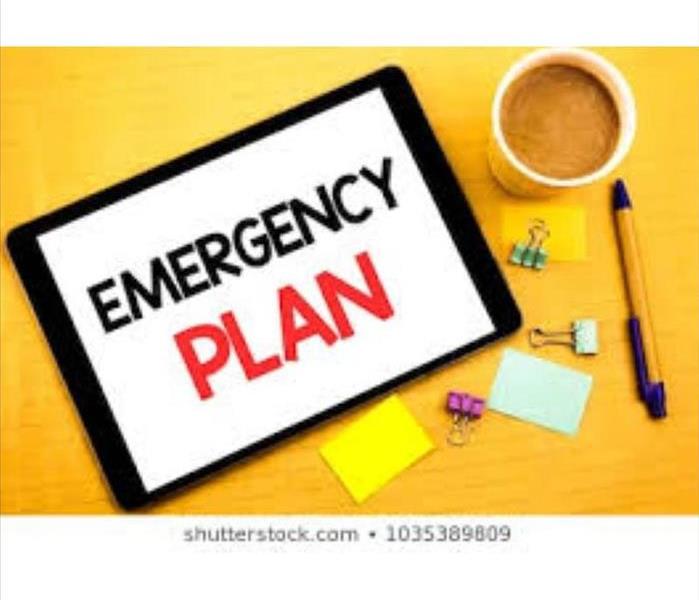 It is very important to have an emergency plan.
It is very important to have an emergency plan.
We all want to keep our family and property safe from dangerous, deadly fires. But do many of us take time to ensure that we, in fact, are safe? Take time to employ these 8 tips for residential fire safety to keep your loved ones and pets out of harm's way.
Avoid Hazards - One of the best ways to prevent residential fires is to avoid certain habits and practices that can lead to blazes. A tried and true rule to always follow is to place all lighters and matches in high areas away from a child's reach. Also use caution when burning candles in the home and teach your children that both matches and lighters are not toys to be played with.
Have a Plan - Have a plan for you and your family on what to do if a fire does occur. Make sure to vary the plan based on where the fire occurs and what type of fire it is. When you have your strategy in place purchase the needed safety tools (IE. fire ladder, fire extinguisher) and place them in the designated areas. You will also want a plan on how to practice your skills to maintain your fire tools such as when to perform a fire extinguisher inspection.
Practice Your Plan - Having a plan in place in the event of a fire is only half of the job. In order for your family to be safe, they must feel comfortable on executing the plan. Take time to practice a fake fire in the home so every family member can rehearse the plan. It may be beneficial to do varying scenarios so that different approaches can be made.
Inspect Your Equipment - Make sure to perform a fire extinguisher inspection on a regular basis to ensure it is in proper working order.
Hire a Chimney Sweep - Have your chimney swept by a professional on a yearly basis preferable before the heating season. Creosote can build up in the flue leaving your chimney vulnerable to a fire.
Educate Yourself - Educate you and your family on basic fire safety skills. There are many educational books geared to children that cover the topic empowering them to make wise choices in the event of a fire in the home.
Alarm Your Home - Always have both a smoke alarm and carbon monoxide detector on each floor of the home. Test both regularly and replace batteries as needed. Carbon monoxide detectors often have an expiration date. To help me remember when the date is approaching, I used a black permanent marker to write the date on the bottom of the unit facing the floor so anytime I look up I can clearly see if the unit is near expiration.
Be Smart - Common sense can go a long way in overall fire safety in the home. Make sure you know the basics of how to protect you and your family from home fires. Also teach your children how to approach fire hazards using good judgment and practical knowledge.
Follow these residential fire prevention tips to keep your family and home safe from a dangerous blaze. Performing a fire extinguisher inspection, sweeping your flue, and the other six tips are all important to maintaining a nontoxic environment for those you love to work and play in.
Tips for Residential Fire Safety
5/5/2020 (Permalink)
We all want to keep our family and property safe from dangerous, deadly fires. But do many of us take time to ensure that we, in fact, are safe? Take time to employ these 8 tips for residential fire safety to keep your loved ones and pets out of harm's way.
Avoid Hazards - One of the best ways to prevent residential fires is to avoid certain habits and practices that can lead to blazes. A tried and true rule to always follow is to place all lighters and matches in high areas away from a child's reach. Also use caution when burning candles in the home and teach your children that both matches and lighters are not toys to be played with.
Have a Plan - Have a plan for you and your family on what to do if a fire does occur. Make sure to vary the plan based on where the fire occurs and what type of fire it is. When you have your strategy in place purchase the needed safety tools (IE. fire ladder, fire extinguisher) and place them in the designated areas. You will also want a plan on how to practice your skills to maintain your fire tools such as when to perform a fire extinguisher inspection.
Practice Your Plan - Having a plan in place in the event of a fire is only half of the job. In order for your family to be safe, they must feel comfortable on executing the plan. Take time to practice a fake fire in the home so every family member can rehearse the plan. It may be beneficial to do varying scenarios so that different approaches can be made.
Inspect Your Equipment - Make sure to perform a fire extinguisher inspection on a regular basis to ensure it is in proper working order.
Hire a Chimney Sweep - Have your chimney swept by a professional on a yearly basis preferable before the heating season. Creosote can build up in the flue leaving your chimney vulnerable to a fire.
Educate Yourself - Educate you and your family on basic fire safety skills. There are many educational books geared to children that cover the topic empowering them to make wise choices in the event of a fire in the home.
Alarm Your Home - Always have both a smoke alarm and carbon monoxide detector on each floor of the home. Test both regularly and replace batteries as needed. Carbon monoxide detectors often have an expiration date. To help me remember when the date is approaching, I used a black permanent marker to write the date on the bottom of the unit facing the floor so anytime I look up I can clearly see if the unit is near expiration.
Be Smart - Common sense can go a long way in overall fire safety in the home. Make sure you know the basics of how to protect you and your family from home fires. Also teach your children how to approach fire hazards using good judgment and practical knowledge.
Follow these residential fire prevention tips to keep your family and home safe from a dangerous blaze. Performing a fire extinguisher inspection, sweeping your flue, and the other six tips are all important to maintaining a nontoxic environment for those you love to work and play in.
Ten Things I Needed During a Power Outage
11/20/2019 (Permalink)
 Top Ten!
Top Ten!
What I Needed During a Power Outage
October was full of unpredictable circumstances. The Kincade fire grew at an exponential rate and endangered our neighborhoods. PG&E had to take drastic precautionary measures by shutting off the power lines to around a million residents of both Sonoma, Napa, and Marin county. Fortunately, we had government support through a declaration of National Emergency which led to the dispatching of firefighters from neighboring cities, counties, and states. These brave people contained the fire and prevented major catastrophe.
The outage was an unfortunate circumstance and there were specific items that I wish I had in my possession to make the experience easier. The next time an outage occurs I want to be prepared and share with you the top ten essential items I needed during a power outage.
Top Ten List:
- First Aid Kit: Safety first!
- Powered Portable Charger(s): Cell phones or laptops are essential for daily living. Having a communication device during an emergency can be a lifesaver. Also, passing the time online when there is no power can make the process easier.
- Batteries: AA, AAA, or a backup battery are useful to power items that require them. Such as a flashlight or have in case you possess items that require batteries. Such as a flashlight, clocks, or radios.
- Flashlight: A flashlight is important for visibility at night. During a power outage, it can be difficult to move around. While I recommend having a LED flashlight, any normal light is useful to have.
- Gas: During the outage, many people had informed me that they were low on gas and therefore confined to their area until the power came back on or until someone can help them get to a gas station with power to be able to transfer gas back to their vehicles. Having a car filled with gas can also be essential for rapidly evacuating during an emergency.
- Cooler: The first thing I thought about during the outage was whether my food was going to spoil since our refrigerator was no longer running. Having a cooler could have erased this worry by transferring the food that would’ve spoiled without refrigeration. Of course, having a cooler alone won’t work in the preservation of your food.
- Manual Can opener: Can openers can be a huge aid when you need to open your non-perishable foods.
- Ice: This is the trickiest item on the list to have since a fire and outage are unpredictable. Ice does not have a long-life span as it melts easily and without refrigeration or a permanent cold environment, ice is a valuable resource that one needs to get an upper-hand when buying since it is the first thing to go at the grocery stores.
- Canned Food or Non-perishables: Being that food is a necessity for survival. Having food that does not perish without electricity can determine life or death. Well at least, that you don’t spend the days starving at least. Food includes: bars, nuts, candies, peanut butter, chips, beef jerky and much more.
- Bottled Water: The most important resource to have access to during a crisis. Preferably not stored in plastic but only if needed. Just make sure you don’t leave the bottles unattended in the car with sunlight directly hitting them.
Disclaimer:
This list is intended for short term emergencies and everyone has different needs therefore different priorities. That was my list of ten things I needed during the power outage. Hopefully, it helps.
Brought to you by SERVPRO® of South San Rafael/Sausalito.
5 Safety Tips for your Fire Escape Plan
10/22/2019 (Permalink)
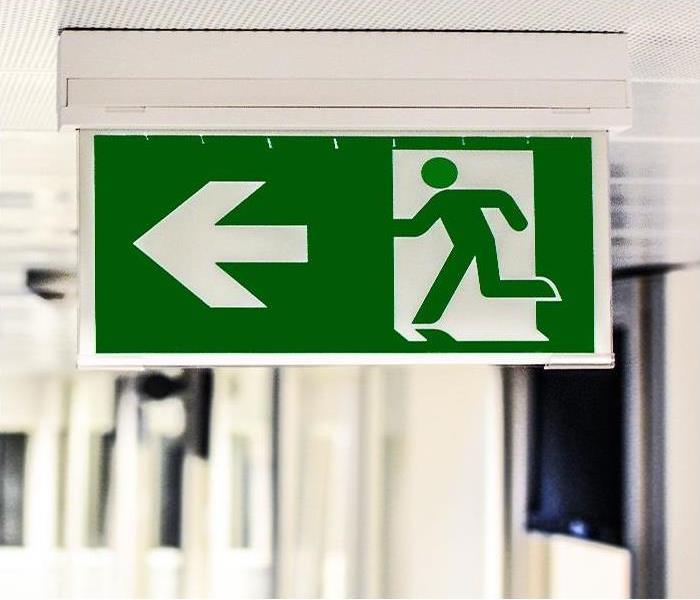 Be safe and prepared with an exit strategy.
Be safe and prepared with an exit strategy.
October is Fire Prevention Month and our team at SERVPRO San Rafael/Sausalito have followed these safety tips shared by the National Fire Protection Association through this year’s National Fire Prevention Week campaign, “Not Every Hero Wears a Cape. Plan and Practice Your Escape!”
Please be safe and follow these tips so that you and your family can escape the fire safely.
- It is important to know the layout of your home. Make an escape plan by drawing a map that shows all your windows and doors, which could potentially be your exit strategy.
Fact: One-third of American households who made an estimate thought they would have at least 6 minutes before a fire becomes life threatening. Unfortunately, the time available could be as little as one to two minutes, according to Lorraine Carli, NFPA’s vice president of Outreach and Advocacy.
- Know at least two ways out of every room, if possible. Make sure all doors and windows leading outside can be easily opened.
Fact: A closed door may slow the spread of smoke, heat, and fire. Make sure to close all doors behind you when exiting a room. Also, check to make sure a door is not hot, that can be an indicator of a fire on the other side.
- Have an outside meeting place (like a tree, light pole or mailbox) a safe distance from the home where everyone should meet.
Fact: Escape planning and practice can help reduce the time to get everyone out. It is best to call the Fire Department when outside your home.
- Practice your escape plan during the day and night with everyone in your home at least twice a year using different ways out. Be extra mindful to teach children how to escape on their own in case you can’t help them.
Fact: While 71% of Americans have an escape plan in case of a fire, only 47% of those have practiced it.
- If the smoke alarm sounds, your first thought should be to get out. Never go back inside for people or pets.
Fact: Only 8% said that their first thought on hearing a smoke alarm would be to get out. Smoke inhalation is also very dangerous. If you need to go through smoke, get low and go under the smoke till you reach your way out.
For more information or resources regarding fire, electrical, or related hazards, please feel free to visit the National Fire Protection Association at https://www.nfpa.org/.
Summer Fire Safety: How to Have a Controlled Camp Fire
8/6/2019 (Permalink)
Whether it is at a festival or other tourist event, camping can be a cheap way to enjoy a relaxing holiday in the summer time. Normally most camping sites don't allow camp fires due to health and safety, however if you can show you are prepared and will have a controlled camp fire, many camping site operators when asked may allow you to have a one in a fire pit.
If a camp site already has a pit make sure you clear out all of the debris before lighting your own one, left over debris can be dangerous as plastics or other toxic materials could be in the debris. A safe pit should be at least 3-4 meters of bare ground surrounded with stones. Having such a large bare area massively reduces the risk of grass fires and makes the whole process much more controlled.
Before even lighting or collecting wood, you must make sure you are correctly prepared with a fire proof bar or stick; A bucket of water or extinguisher and a clear plan of action is needed in case it becomes out of control.
Things you need to think about before lighting are, where a phone is in case you require the fire department, are all exits away from the fire clear, is there any object located around the pit at risk of being ignited. If you ever have any doubt about the proximity of surrounding objects check beforehand. It is not uncommon for trees or plastic structures around fires to become damaged and in some cases ignite during large camp fires.
Only when you are 100% sure that you have negated all potential risks can you light the kindling. After it is ignited you must always keep watch for pieces that fallout. These should either be pushed back into the middle of the pit, with a fire proof bar or doused in water if it is too close to the to get near. A high number of grass and forest fires around the world are caused by ignited wood falling onto dry grass or leaves.
After you are finished with the pit, you should make sure all embers are away from the pit edge. This stops any risk of the embers igniting the grass or leaves surrounding the fire pit. If you have a bucket of water dousing the fire is a good idea. You should supervise until it is cool, normally this can take 1-2 hours to cool down, during this time it is a good idea to check the fire every 5-10 minutes to make sure it does not reignite.
If you treat camp fires with the respect they deserve they are a really nice way to spend a cool summer's night, above all make sure you are prepared and follow all instructions made by the camp site operators.
Article Source: https://EzineArticles.com/expert/Darren_Drogan/1360550
Summer Fire Safety - BBQ Preparation
8/6/2019 (Permalink)
The sun is out and it's time to barbecue, whether you plan to resurrect your old BBQ from the shed or purchase a shiny new one. However, it is important to remember the risk that fire can pose; so before you start grilling, take note of this important BBQ fire safety advice.
Fire Safety is Key
Before you even light the flames on your BBQ you need to think about a number of factors. Where are you going to place it? Which fuel are you using (natural gas, charcoal or propane)? How will you extinguish the flames in an emergency?
Where you place your BBQ is really important. Ideally it has to be in a clear space, with no overhanging branches or nearby debris which could potentially catch fire. You should also try and place it out of the wind so there's no danger of flames being blown on to the chef. It's also key to ensure that the unit is on solid ground with no risk of tipping or rolling.
Which fuel are you using in your BBQ? Charcoal fires are the most common to cook on during the summer and are located in fire pits, barbecue units and disposable barbecues. Make sure that you only use enough charcoal to cover the base of the BBQ and that you only light it when the coals are cold. Keep excess charcoal in a safe place away from the fire.
If you use a natural gas or propane fuel source there are a number of other factors to consider. Always use a new gas cylinder every summer as cold temperatures during the winter months can damage the casing and remember to change the gas fuel source outdoors or in a very well-ventilated area. Before you light your BBQ for the first time take some time to check the gas set-up for leaks - you can do this by brushing soapy water around the joints of the pipe work, if you see any bubbles this indicates a gas leak.
Prepare a bucket of cold water or sand and keep this close to the barbecue during its use. If the flames are out of control (and you can't simply turn off the gas supply) don't hesitate to douse the flames - even if it means your food will be ruined - as fire safety is always paramount. Enjoy having fun in the sun and remember to stay safe when using fire outside to cook delicious food.
Article Source: https://EzineArticles.com/expert/Darren_B_Drogan/1112444
Fire Safety and You - Top 10 Fire Safety Habits to Live By
5/6/2019 (Permalink)
Live a fire safe life-this is the constant tip of many firefighters and fire experts in this country. The only problem is that some people are just not aware on how to practice fire safety habits and how to avoid fire accidents that cause damages to properties and loss of lives.
The good news is that fire safety habits are simple and easy that anyone can make them a part of his daily life. To know the top habits to live by, here are the things that you should bear in mind:
1. Be careful in handling flammable and combustible materials.
You should always take the necessary precautions when handling anything that is flammable. Make sure you store them in a secure storage far from any combustible material.
2. Practice cautious cooking in the kitchen.
When cooking in the kitchen, it is advisable that you avoid wearing loose fitting clothing and that you always have a fire blanket or fire extinguisher ready in case of a grease fire. Never let children be involved with cooking tasks that involve the use of fire.
3. Keep fire starters and anything flammable out of children's and pets' reach.
Matches, lighters, and candles should be kept in places that children and pets cannot reach. Children are typically curious and if you are not careful, they can end up creating a big fire that can result in a tragedy.
4. Maintain electrical equipment properly.
As for electrical equipment, fire hazards include damaged electrical conductors, overloaded sockets and extension cords, faulty wirings, blown fuses, low quality electrical equipment, malfunction of electrical devices, and loose electrical connections.
Use only high quality electrical equipment and inspect them regularly to see any signs of defect or damage. If there is something wrong, have this repaired by a professional immediately. Avoid overloading sockets as well.
5. Use heating devices with care.
Heating devices especially space heaters that use gas and kerosene can start a fire if not used with proper precaution. Make sure you place them in a location that cannot be reached by children and that is far away from heat sources like furnace, stove or fireplace.
6. Know how to use fire safety devices.
It is essential to know how to use fire safety devices such as fire extinguishers, fire blankets, and fire hose so that when the time comes that there is a fire outbreak, you would know how to tackle a small incipient fire before it gets worse.
7. Learn what to do in case of fire.
Know the basic fire emergency procedures and share this knowledge with the rest of the family.
8. Do not leave burning candles unattended.
Candles should be put out before you leave or sleep. Place them in a location that is not near the window, sheets or curtains.
9. Douse cigarettes in water before disposal.
Smoking is another major cause of fires so it is necessary that you properly extinguish your cigarette before you dispose of it. Moreover, avoid smoking in bed and before you sleep.
10. Formulate a fire escape route for your home.
An escape route plan should easy and simple to understand and should be placed in every level of your home.
It is not that complicated to practice fire safety habits as long as you have the presence of mind and the determination to keep your family and home safe from a fire accident.
Article Source: https://EzineArticles.com/expert/Ben_Griston/324634
8 Tips For Residential Fire Safety
5/6/2019 (Permalink)
We all want to keep our family and property safe from dangerous, deadly fires. But do many of us take time to ensure that we, in fact, are safe? Take time to employ these 8 tips for residential fire safety to keep your loved ones and pets out of harm's way.
Avoid Hazards - One of the best ways to prevent residential fires is to avoid certain habits and practices that can lead to blazes. A tried and true rule to always follow is to place all lighters and matches in high areas away from a child's reach. Also use caution when burning candles in the home and teach your children that both matches and lighters are not toys to be played with.
Have a Plan - Have a plan for you and your family on what to do if a fire does occur. Make sure to vary the plan based on where the fire occurs and what type of fire it is. When you have your strategy in place purchase the needed safety tools (IE. fire ladder, fire extinguisher) and place them in the designated areas. You will also want a plan on how to practice your skills to maintain your fire tools such as when to perform a fire extinguisher inspection.
Practice Your Plan - Having a plan in place in the event of a fire is only half of the job. In order for your family to be safe, they must feel comfortable on executing the plan. Take time to practice a fake fire in the home so every family member can rehearse the plan. It may be beneficial to do varying scenarios so that different approaches can be made.
Inspect Your Equipment - Make sure to perform a fire extinguisher inspection on a regular basis to ensure it is in proper working order.
Hire a Chimney Sweep - Have your chimney swept by a professional on a yearly basis preferable before the heating season. Creosote can build up in the flue leaving your chimney vulnerable to a fire.
Educate Yourself - Educate you and your family on basic fire safety skills. There are many educational books geared to children that cover the topic empowering them to make wise choices in the event of a fire in the home.
Alarm Your Home - Always have both a smoke alarm and carbon monoxide detector on each floor of the home. Test both regularly and replace batteries as needed. Carbon monoxide detectors often have an expiration date. To help me remember when the date is approaching, I used a black permanent marker to write the date on the bottom of the unit facing the floor so anytime I look up I can clearly see if the unit is near expiration.
Be Smart - Common sense can go a long way in overall fire safety in the home. Make sure you know the basics of how to protect you and your family from home fires. Also teach your children how to approach fire hazards using good judgment and practical knowledge.
Follow these residential fire prevention tips to keep your family and home safe from a dangerous blaze. Performing a fire extinguisher inspection, sweeping your flue, and the other six tips are all important to maintaining a nontoxic environment for those you love to work and play in.
Article Source: https://EzineArticles.com/expert/Ximena_Duncan/1742319
Facts about Holiday Fires
12/12/2018 (Permalink)
Holidays are here and the U.S Fire Administration has some facts we at SERVPRO of S. San Rafael / Sausalito find really import to share:
- One of every four home Christmas tree fires is caused by electrical problems.
- Although Christmas tree fires are not common, when they do occur, they are more likely to be serious. On average, one of every 32 reported home Christmas tree fires results in a death compared to an average of one death per 143 total reported home fires.
- A heat source too close to the tree causes one in every four Christmas tree fires.
- The top three days for home candle fires are Christmas, New Year’s Day, and Christmas Eve.
- Candles start two out of five home decoration structure fires.
Content Source:
https://www.usfa.fema.gov/prevention/outreach/holiday.html
Is Cooking Dangerous?
12/6/2018 (Permalink)
The answer is NO! But cooking is the number 1 cause of fires in homes.
We all love a good meal and with the Holidays coming we hope you all have great meals coming out safe of your kitchens. We brought you information about how to be even safer.
First most fires in the kitchen are man-made, so keep an eye while in the kitchen. here are some safety tips:
House fires happen most during dinner hours—between 5:00 and 8:00 p.m.
- For grease fires, only use a fire extinguisher (class B) or baking soda. Do not use water! It will spread the oil/grease and make your fire worse.
- Never leave your food unattended. Fires only need 30 seconds to go from a small flame to an out-of-control blaze, so even going to the bathroom could endanger your home.
- Turn off the stove and all appliances once you’re done cooking.
- Keep everything off hot surfaces. For instance, don’t throw a dish towel on top of the stove, because it could still be hot!
- Don’t wear baggy clothing. It could catch fire accidentally.
- Keep the grill at least 10 feet from vegetation and the house.
And remember, we at SERVPRO of S. San Rafael / Sausalito are here to help in case of emergency to make it Like it Never Even Happened.
Content source:
https://www.safewise.com/blog/the-most-common-places-that-fires-occur-in-the-home/
FIRE SAFETY IN MANUFACTURED HOMES
8/20/2018 (Permalink)
About manufactured homes
Manufactured homes (sometimes called "mobile" homes) are transportable structures that are fixed to a chassis and specifically designed to be towed to a residential site. They are not the same as modular or prefabricated homes, which are factory-built and then towed in sections to be installed at a permanent location.
In order to distinguish between modular, prefabricated and recreational trailer homes, the following definition for a manufactured home from NFPA 501, Standard on Manufactured Housing, applies:
A structure, transportable in one or more sections that in the traveling mode is 8 body-ft (2.4 m) or more in width or 40 body-ft (12.2 m) or more in length or that on site is 320 ft2 (29.7m2) or more, is built on a permanent chassis, is designed to be used as a dwelling with or without a permanent foundation, whether or not connected to the utilities, and includes plumbing, heating, air-conditioning, and electrical systems contained therein. Such terms shall include any structure that meets all the requirements of this paragraph except the size requirements and with respect to which the manufacturer voluntarily files a certification required by the regulatory agency. Calculations used to determine the number of square feet in a structure are based on the structure’s exterior dimensions, include all expandable rooms, cabinets, and other projections containing interior space, but do not include bay windows.
The federal government regulates the construction of manufactured housing. Since 1976, manufactured homes have been required to comply with U.S. Department of Housing and Urban Development (HUD) manufactured housing construction and safety standards, which cover a wide range of safety requirements, including fire safety. Post-1976 manufactured homes bear a label certifying compliance with these standards.
The HUD standard has been enhanced over the years and the HUD "Final Rule" for smoke alarms in manufactured homes is largely based upon NFPA 501. Today, new construction of manufactured housing is required to contain, among other provisions:
- factory installed hard wired or 10 year battery source, interconnected smoke alarms with battery back-up (including alarms inside or immediately adjacent to all rooms designated as sleeping areas, top of the stairs and on the basement ceiling near the stairs)
- provisions for special devices for hearing and visually impaired persons.
NFPA's national fire data indicate that manufactured homes built to HUD standards (post-1976 construction) have a much lower risk of death if fire occurs compared to pre-standard manufactured homes. The latest data (2007-2011) also shows that the overall fire death rate per 100,000 housing units is roughly the same for manufactured homes and for other one- or two-family homes.
Despite the federal requirements for factory-installed smoke alarms and the fact that eight out of ten manufactured homes now are and seven out of ten manufactured home fires now involve post-HUD-Standard units (based on 2007-2011 data), 51 percent of fires in manufactured homes were reported as having no smoke alarms present. This suggests a problem with detection devices being removed by occupants.
Safety tips
To increase fire safety in manufactured homes, NFPA offers the following guidelines:
- Choose a HUD-certified manufactured home
If you are in the market to purchase or rent a manufactured home, select a home built after 1976 that bears the HUD label certifying compliance with safety standards. - Keep smoke alarms working
Never remove or disable a smoke alarm. If you experience frequent nuisance alarms, consider relocating the alarm further away from kitchen cooking fumes or bathroom steam. Selecting a photoelectric smoke alarm for the areas nearest kitchens and baths may reduce the number of nuisance alarms experienced. As an alternative, NFPA 501 permits a smoke alarm with a silencing means to be installed if it is within 20 feet of a cooking appliance. Test all smoke alarms at least once a month by pushing the "test" button. It is not necessary to use smoke or a real flame to test the smoke alarm's operability, and it is risky to do so. Replace batteries at least once a year, and when the alarm "chirps," signaling low battery power. Occasionally dust or lightly vacuum smoke alarms. - Make sure you have enough smoke alarms
If your older manufactured home does not have smoke alarms in or near every sleeping room and in or near the family/living area(s), immediately install new alarms and fresh batteries to protect these rooms. For the best protection, interconnect all smoke alarms throughout the home. When one sounds, they all sound. - Plan your escape
Know ahead of time how you will get out if you have a fire. Develop an escape plan which includes having an alternate exit out of every room. Make sure you can open and get out of windows and doors. All post-HUD Standard manufactured homes are required to provide windows designed for use as secondary escape routes for the bedroom. Familiarize yourself with their operation and don't block access to them. Immediately fix any windows that have been painted or nailed shut, doors that are stubborn or "stuck," and locks that are difficult to operate. Security bars or grates over windows or doors should have quick-release devices installed inside, which allow you to open them in an emergency. Hold a fire drill twice a year to rehearse how you will react if the smoke alarm sounds. - Electrical
Hire a licensed electrician if you notice flickering lights, frequent blown circuits, or a "hot" smell when using electricity. Use extension cords for temporary convenience, not as a permanent solution. Avoid overloading electrical receptacles (outlets). Electrical cords should not be run under carpets or rugs, as the wires can be damaged by foot traffic, then overheat and ignite the carpet or rug over them. Ground-fault circuit interrupters reduce the risk of electrical shock and should be installed by electricians in kitchens and baths. Arc Fault Circuit Interrupters monitor electric circuits for arcing and should be installed by electricians on bedroom circuits. - Cooking
Unattended cooking is the leading cause of cooking fires in U.S. homes. Supervise older children who cook and stay in the kitchen when heating anything on the stove. Keep cooking surfaces clean and place anything that can burn well away from the range. Heat oil slowly and know how to slide a lid over a pan if you experience a grease fire. Read more cooking safety tips. - Heating
Keep space heaters at least three feet away from anything that can burn. When purchasing new space heaters, select appliances with automatic shut-off switches. Kerosene heaters are illegal for home use in some jurisdictions. Check with your local fire department before purchasing a kerosene heater. Turn off portable space heaters before falling asleep or when leaving the room. Refill kerosene heaters outdoors, after the heater has cooled down. Supervise children and pets when space heaters are operating. Read more heating safety tips. - Walls
All post-HUD Standard manufactured homes are required to have wall linings that do not promote rapid flame spread, with special protection around primary heating and cooking equipment, such as the furnace and cooking range. Presently, gypsum wallboard has replaced plywood wall paneling and wood based ceiling panels in the fabrication of manufactured housing walls and ceilings. This action has dramatically reduced the impact of fires in manufactured homes. Do not mount anything on the walls – such as paneling, drapery, or wall hangings – that would reduce this protection, especially near major heat sources. - Smoking
If you have smokers in your home, ask them to smoke outside. Wherever people smoke, set out large, non-tip ashtrays on level surfaces and empty them frequently. Thoroughly douse butts with water before discarding. Check around and under cushions for smoldering butts. Read more smoking safety tips. - Protect yourself from intruders
Install outdoor lighting to deter intruders, including would-be arsonists. Keep gasoline, charcoal lighter and other flammable liquids locked in an outdoor shed. Don't store items underneath your home. Store firewood away from your home and keep trash and other flammable debris cleaned up. Report any suspicious activity in your neighborhood.
http://www.nfpa.org/safety-information/for-consumers/escape-planning/fire-safety-in-manufactured-homes
Smoke and Soot Cleanup
8/13/2018 (Permalink)
Smoke and soot is very invasive and can penetrate various cavities within your home, causing hidden damage and odor. Our smoke damage expertise and experience allows us to inspect and accurately assess the extent of the damage to develop a comprehensive plan of action.
Smoke and soot facts:
- Hot smoke migrates to cooler areas and upper levels of a structure.
- Smoke flows around plumbing systems, seeping through the holes used by pipes to go from floor to floor.
- The type of smoke may greatly affect the restoration process.
Different Types of Smoke
There are two different types of smoke–wet and dry. As a result, there are different types of soot residue after a fire. Before restoration begins, SERVPRO of South San Rafael / Sausalito will test the soot to determine which type of smoke damage occurred. The cleaning procedures will then be based on the information identified during pretesting. Here is some additional information:
Wet Smoke – Plastic and Rubber
- Low heat, smoldering, pungent odor, sticky, smeary. Smoke webs are more difficult to clean.
Dry Smoke – Paper and Wood
- Fast burning, high temperatures, heat rises therefore smoke rises.
Protein Fire Residue – Produced by evaporation of material rather than from a fire
- Virtually invisible, discolors paints and varnishes, extreme pungent odor.
Our Fire Damage Restoration Services
Since each smoke and fire damage situation is a little different, each one requires a unique solution tailored for the specific conditions. We have the equipment, expertise, and experience to restore your fire and smoke damage. We will also treat your family with empathy and respect and your property with care.
Have Questions about Fire, Smoke, or Soot Damage?
Call Us Today – (415) 479-2900
Common Causes of Kitchen Fires
5/24/2018 (Permalink)
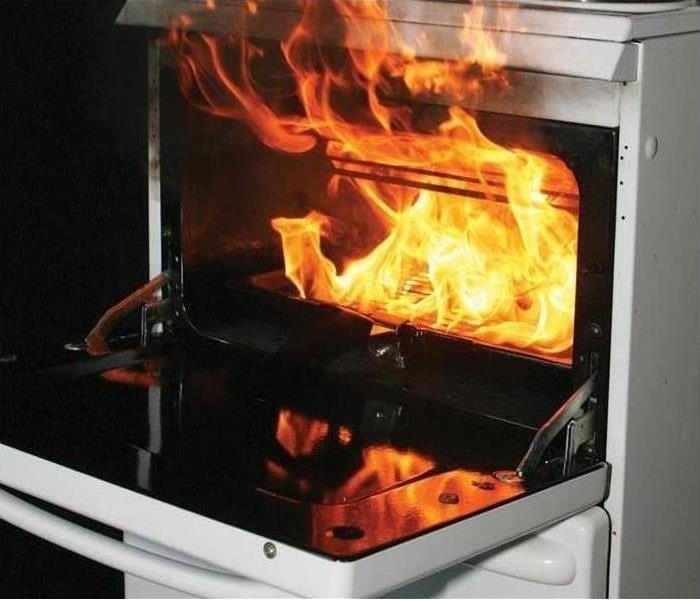 SERVPRO of South San Rafael / Sausalito (415) 479-2900
SERVPRO of South San Rafael / Sausalito (415) 479-2900
The kitchen is the source of many fire hazards because it's where heat, electricity, water and grease come together. The most common type of fire is the grease fire. A grease fire is extremely dangerous as it can get out of control quickly and spread from the stove throughout the kitchen and into other rooms of the house.
Common Causes of Kitchen Fires
- Too high temperature in the fryer
- Vegetable, more flammable, oils
- Old, more flammable oil, in the deep fryer
- Fat deposits in the flue and ventilation ducts
- Misalignment sprinklers due to equipment moved around
- Clogged melting links of the sprinklers leading to impaired function
Other types of kitchen fires include oven fire or the microwave. When a fire starts, keep the door closed and turn off the oven. The lack of oxygen will suffocate the flames. If continues to smoke like a fire use a fire extinguisher or call fire department.
At SERVPRO of South San Rafael / Sausalito we are available 24 hours and 7 days a week. Give us a call at (415) 479-2900. We can help make any fire damage you are facing and make it, "Like it never even happened!"
Pet fire safety tips
5/24/2018 (Permalink)
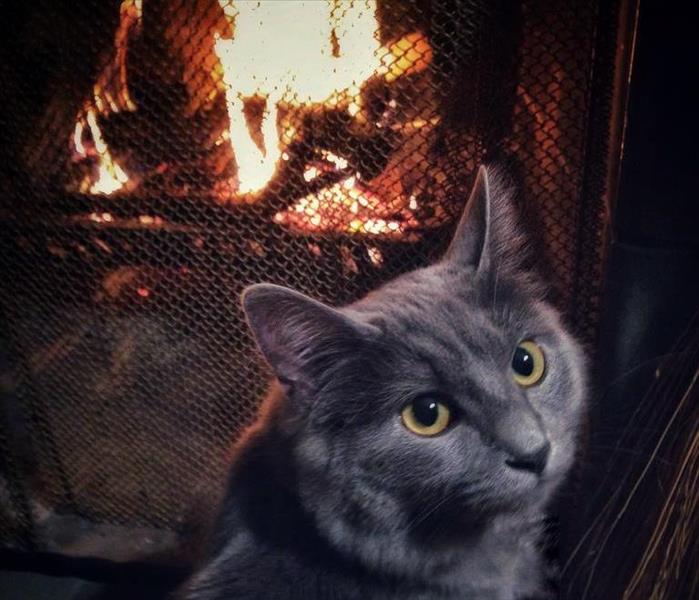 SERVPRO of South San Rafael / Sausalito (415) 479-2900
SERVPRO of South San Rafael / Sausalito (415) 479-2900
- Pets are curious. They may bump into, turn on, or knock over cooking equipment. Keep pets away from stoves and counter tops
- Keep pets away from candles, lamps, and space heaters.
- Always use a metal or heat-tempered glass screen on a fireplace and keep it in place.
- Keep pets away from a chimney’s outside vents. Have a “pet-free zone” of at least 3 feet (1 meter) away from the fireplace. Glass doors and screens can stay dangerously hot for several hours after the fire goes out.
- Consider battery-operated, flameless candles. They can look and smell like real candles.
- Some pets are chewers. Watch pets to make sure they don’t chew through electrical cords. Have any problems checked by a professional.
- Have working smoke alarms on every level of the home. Test your smoke alarms at least once a month.
- If the smoke alarm sounds, get out and stay out.
- Never go back inside for pets in a fire. Tell firefighters if your pet is trapped.
At SERVPRO of South San Rafael / Sausalito we are available 24 hours and 7 days a week. Give us a call at (415) 479-2900. We can help make any fire damage you are facing and make it, "Like it never even happened!"
SERVPRO’s Tips to Prevent Fire Damage in Your Home
12/13/2017 (Permalink)
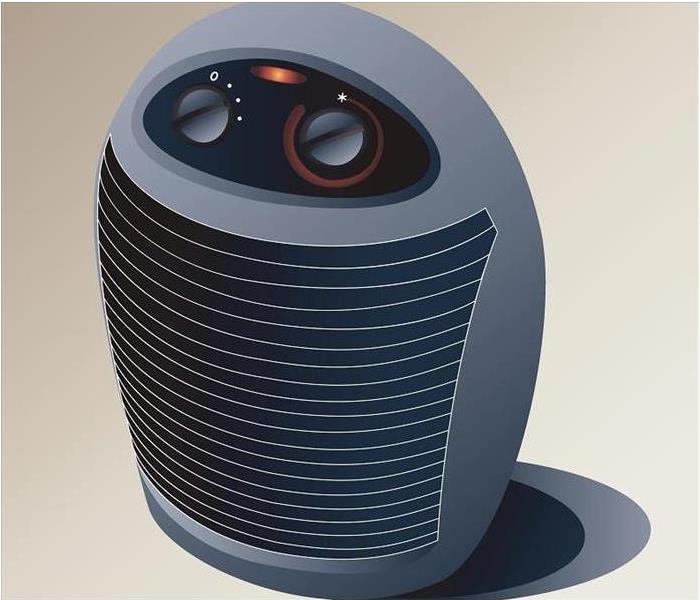 SERVPRO recommends never leaving a portable heater unattended in your home.
SERVPRO recommends never leaving a portable heater unattended in your home.
Space heaters can be a great way to warm up the coldest areas of your house throughout the harshest of winter months. They are not without their potential threats, however. Monitoring them carefully and not leaving these heaters running unattended can help prevent unnecessary damage to your home, let alone those who live inside of it.
Electric and gas space heaters offer a great deal of warmth and can completely transform the coldest areas of your house into the most comfortable. They also put out lots of concentrated heat, and many of them feature grills or open flames that burn hot enough to scald a person or to catch loosely hanging fabrics or drapes on fire. There are some words of caution about these heaters if you want to virtually eliminate the possibility of fire damages to your residence.
The first step is to consider the placement of your heater very wisely. While it might require being close enough to an outlet to plug in, you should be mindful of the furniture and other objects in the room that could inadvertently make contact with the heater. With the excessive heat and open design of many of the small room heaters, something left too close to the heat could catch on fire (even without directly touching).
As many of our experienced SERVPRO team would tell you, preventing fire damage is often as simple as walking yourself through all of the scenarios that might happen. People do not intend to set their homes on fire, but these accidents can happen with a lack of foresight. As an added precaution, you should not leave these types of heaters on unattended in a room that you are not currently occupying.
While regrettable, house fires and small incidents do occur when using space heaters. While it might not be significant enough to force you to leave the house, sometimes the remains of the soot or the lingering odor of burned materials can be more than you can repair or remedy on your own. Our fire restoration team is equipped with deodorizing equipment to neutralize smoke and foul odors, and our commitment to mitigating your loss ensures that we restore the damage promptly.
No matter what degree of fire damage you might have to deal with, you can trust us at SERVPRO of South San Rafael/Sausalito to make it right. Call us 24/7 at (415) 479-2900.
Dangers of Frying A Turkey
12/13/2017 (Permalink)
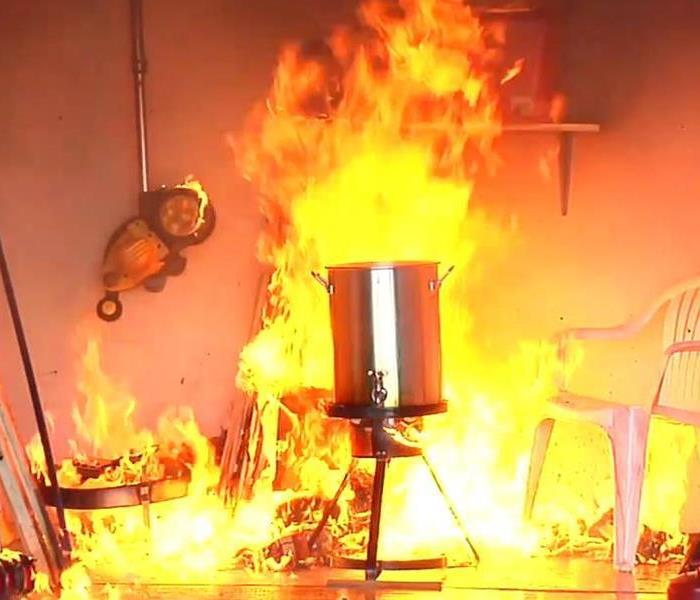 A turkey should never be fried in an enclosed space
A turkey should never be fried in an enclosed space
In recent years deep-frying turkeys has become increasingly popular. The cooking method requires placing the turkey in 3 gallons or more of oil, heated by propane.
The SERVPRO warns that cooking with deep-fat turkey fryers can be very dangerous as they have a high risk of tipping over, overheating, or spilling hot oil and could lead to fires, burns, or other injuries.
5 Dangers of Frying a Turkey
Here are 5 dangers associated with deep frying a turkey, according to SERVPRO:
- A small amount of cooking oil coming into contact with the burner can cause a large fire.
- An overfilled cooking pot or partially frozen turkey will cause cooking oil to spill when the turkey is inserted.
- The sides of the cooking pot, lid and pot handles can get dangerously hot, creating severe burn hazards.
- Units can easily tip over, spilling hot cooking oil over a large area.
- Without thermostat controls, deep fryers have the potential to overheat the oil to the point of combustion.
Turkey Frying Safety Tips
SERVPRO advises against using a turkey fryer. If you decide to do it anyway, these precautions should be followed. Please follow these tips to stay safe:
- Do not overfill the fryer.
- Fryers should always be used outdoors, on a solid level surface a safe distance from buildings and flammable materials.
- If a turkey fryer fire occurs, call 911 immediately.
- Keep all-purpose fire extinguishers nearby.
- Make sure the turkey is completely thawed before it is placed in a fryer.
- Never leave the fryer unattended because, without thermostat controls, the oil will continue to heat until it catches fire.
- Never let children or pets near the fryer when in use or after use as the oil can remain hot for hours.
- Never use a fryer on a wooden deck, under a patio cover, in a garage or enclosed space.
- Use well-insulated potholders or oven mitts and wear long sleeves and safety goggles to protect from splatter.
About SERVPRO of South San Rafael/Sausalito
SERVPRO of South San Rafael/Sausalito specializes in the cleanup and restoration of residential and commercial property after a fire, smoke or water damage event. Our staff is highly trained in property damage restoration. From initial and ongoing training at SERVPRO’s corporate training facility to regular IICRC-industry certification, rest assured our staff is equipped with the knowledge to restore your property. SERVPRO of South San Rafael/Sausalito has the experience and training to make your home safe and livable again. Call us at 415-479-2900 to learn more about our professional cleanup services.
Understanding the Different Types of Smoke Damage
8/21/2017 (Permalink)
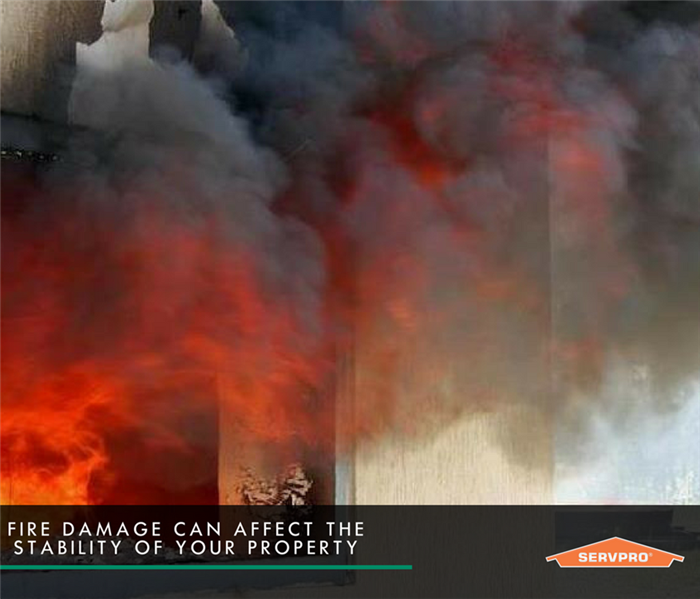 Knowing the different types of smoke and their behavior patterns are vital to proper cleanup and restoration.
Knowing the different types of smoke and their behavior patterns are vital to proper cleanup and restoration.
After the fire truck leaves, your Sausalito home likely suffers from a serious smoke and soot damage. Smoke damage can exist in many forms and each type can have different levels of impact on your property and require different method for restoration. Since smoke and soot is very invasive, they can penetrate into materials causing discoloration and odors, and can leave behind residue buildup. SERVPRO of S. San Rafael/Sausalito professionals are thoroughly trained in fire cleanup and restoration. Our technicians know the different types of smoke and their behavior patterns, which is vital to proper restoration.
Smoke and Soot Facts:
- Hot smoke migrates to cooler areas and upper levels of a structure.
- Smoke flows around plumbing systems, seeping through the holes used by pipes to go from floor to floor.
- The type of smoke may greatly affect the restoration process.
Different Types of Smoke
There are two different types of smoke–wet and dry. As a result, there are different types of soot residue after a fire. Before restoration begins, SERVPRO of S. San Rafael/Sausalito will test the soot to determine which type of smoke damage occurred. The cleaning procedures will then be based on the information identified during pretesting. Here is some additional information:
- Dry Smoke Residue– Dry smoke residue occurs during fast burning fires that burn at a high temperature. Dry smoke residue is generally dry, powdery, and does not smear much.
- Wet Smoke Residue-Wet smoke residue occurs from smoldering fires with low heat. Dry smoke residue is sticky with strong smoke odors. During cleaning, wet smoke residue can smear, making cleanup more difficult.
- Protein Residue– Protein residue is essentially invisible and it can discolor paints, varnishes, and other finishes. Although this residue is not very visible, it has a very strong smell.
- Fuel / Oil Residue– Fuel oil residue rarely comes from fires unless petroleum products were being stores on site. More commonly fuel and oil residue restoration comes from furnace puff backs that cause a fuel oil soot. This can be relatively sticky and difficult to clean.
- Other Types – Tear gas, fingerprinting powder and fire extinguisher residue.
Since each smoke and fire damage situation is a little different, each one requires a unique solution tailored for the specific conditions. We have the equipment, expertise, and experience to restore your fire and smoke damage. We will also treat your family with empathy and respect and your property with care.
Have Questions about Fire, Smoke, or Soot Damage? Call Us Today – (415) 479-2900
Wildfire Prevention and Safety Tips
8/15/2017 (Permalink)
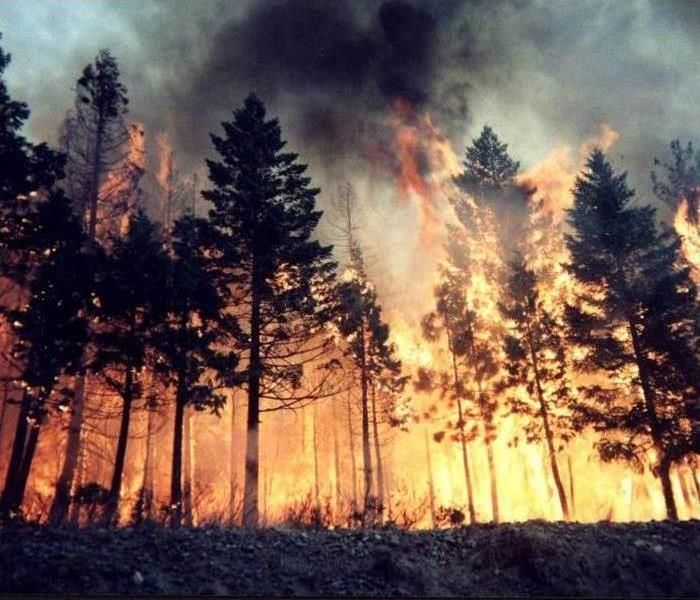 If your home or business is damaged by wildfires, SERVPRO of S. San Rafael/Sausalito can help restore your property to preloss condition.
If your home or business is damaged by wildfires, SERVPRO of S. San Rafael/Sausalito can help restore your property to preloss condition.
Wildfires can occur at anytime and anywhere throughout the year. Late summer and early fall is typically the peak time for wildfires in California. People that live or work in an area prone to wildfires are at greater risk. Wildfires sometimes start naturally by heat ignited from sun light or lightning strikes. However, majority of the wildfires in the U.S. are caused by humans. Some human-caused fires result from campfires left unattended, negligently discarded cigarettes or intentional acts of arson. A wildfire can move as fast as 6.5 miles per hour in forest and 14 miles an hour in grassland, consuming trees, homes, natural resources, humans and everything in its path.
By working together, we can make our residents and neighborhood safer from wildfires by taking safety precautions. Here are some wildfire safety tips to help prevent wildfire from occurring.
Wildfire Safety Tips
- Clear leaves and other debris from gutters, eaves, porches and decks. Remove dead vegetation from under your deck and within 10 feet of the house. This prevents embers from igniting your home.
- Remove anything stored underneath decks or porches. Screen or box-in areas below patios and decks with wire mesh to prevent debris from accumulating.
- Ensure flammable materials (firewood stacks, propane tanks, dry vegetation) are more than 30 feet from your home or business's foundation and outbuildings.
- Wildfire can spread to tree tops. If you have trees on your property, prune so the lowest branches are 6 to 10 feet from the ground.
- Keep your lawn hydrated and maintained. If it is brown, cut it down to reduce fire intensity. Dry grass and shrubs are fuel for wildfire.
- Inspect shingles or roof tiles. Replace or repair shingles that are loose or missing to prevent ember penetration.
- Cover exterior attic vents with metal wire mesh no larger than 1/8 inch to prevent sparks from entering the home.
- Enclose eaves and screen soffit vents using 1/8 mesh metal screening to prevent ember entry.
SERVPRO of S. San Rafael/Sausalito specializes in fire and water damage restoration. We have the specific damage restoration training, personnel, and equipment and can quickly restore your home to pre-fire condition. Call us today 415-479-2900.
Grilling Safety Tips
5/26/2017 (Permalink)
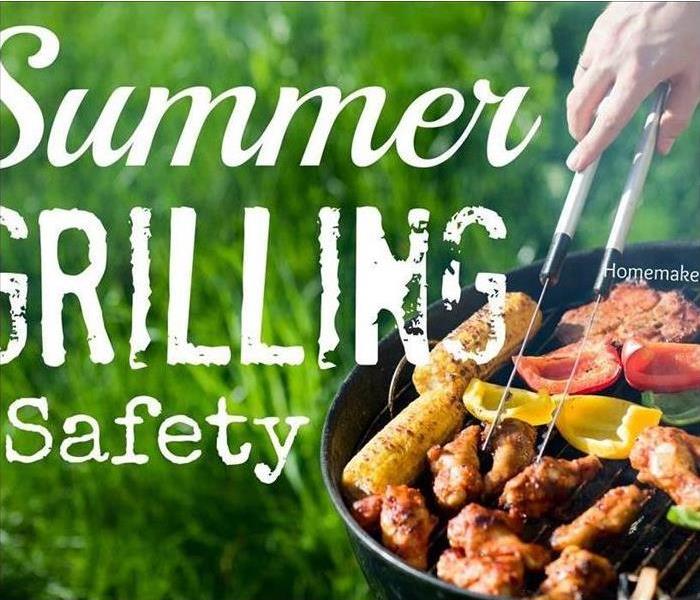 Follow these simple grilling safety tips to keep your family and friend safe during the cookout season.
Follow these simple grilling safety tips to keep your family and friend safe during the cookout season.
When the weather gets warmer, there’s nothing better than the smell of food on the grill. Grilling and cookouts are the most popular activities outdoor. It’s a great way to relax and have fun with family and friends. Weather the barbecuing takes place at the beach, picnic area, camping site or just out in the backyard, grilling can poses risk of fire if not handled properly. According to a (NFPA) National Fire Protection Association report, nearly 9,000 homes fires are caused by grilling in the US and close to half of all injuries involving grills are due to thermal burns.
Causes of Grill Fires:
The leading causes of grill fires were a failure to clean, having the grill too close to something that could catch fire and leaving the grill unattended.
A leak or break was the leading cause for outside or unclassified grill fires. Leaks or break were primarily a problem with gas grills.
General Grilling Tips:
- Propane and charcoal BBQ grills should only be used outdoors.
- The grill should be placed well away from the home, deck railings and out from under eaves and overhanging branches.
- Keep children and pets away from the grill area.
- Keep your grill clean by removing grease or fat buildup from the grills and in trays below the grill.
- Never leave your grill unattended.
If you encounter fire damage during this cookout season, give SERVPRO of S.San Rafael/Sausalito a call. We're dedicated to being faster to any size disaster, has the training, equipment and expertise to handle your restoration and cleaning needs. We’re close by and ready to respond immediately when you need us. We make disaster "Like it never even happened." Call us today at (415) 479-2900.
Fire Safety Tips When Cooking
5/26/2017 (Permalink)
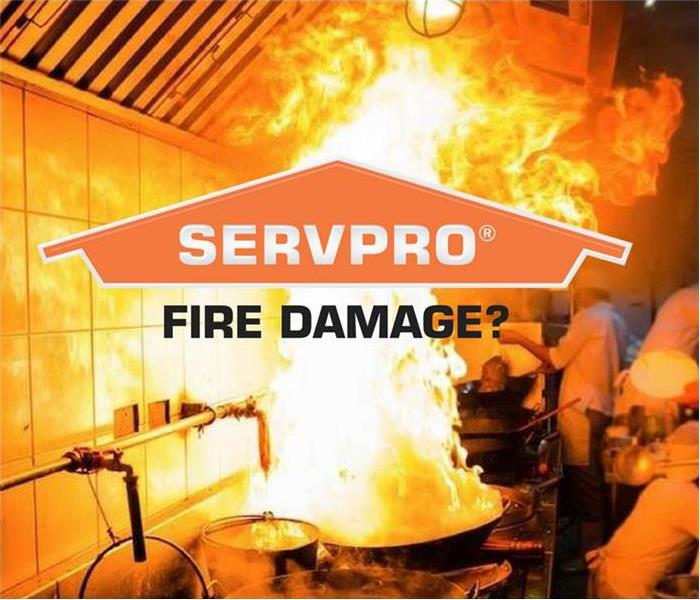 Follow these fire safety tips, be alert and watch what you are cooking at all times.
Follow these fire safety tips, be alert and watch what you are cooking at all times.
As we look forward to the upcoming holiday season of Memorial Day, Independence Day and Labor day (to name a few) many of us will invite our family and friends to celebrate these major holidays. These can be exciting especially preparing some delicious dishes for the party. Whether you’re cooking indoor or outdoor, there is always a potential for fire hazard in the kitchen or in the backyard. Did you know that U.S. fire departments responded to an average of 166,100 home structure fires that involved cooking equipment per year? The leading cause of fires in the kitchen is unattended cooking. So before you turn on your stove, here are some fire safety tips prevention.
Here's What You Need to Know:
• Be on alert! If you are sleepy or have consumed alcohol don’t use the stove or stove top.
• Stay in the kitchen while you are frying, grilling, boiling or broiling food.
• If you are simmering, baking or roasting food, check it regularly, remain in the kitchen while food is cooking, and use a timer to remind you that you are cooking.
• Keep anything that can catch fire—oven mitts, wooden utensils, food packaging, towels or curtains—away from the stovetop.
What to Do During a Fire:
• Just get out! When you leave, close the door behind you to help contain the fire.
• Call 9-1-1 or the local emergency number after you leave.
• For an oven fire turn off the heat and keep the door closed.
• If you try to fight the fire, be sure others are getting out and you have a clear way out.
• Keep a lid nearby when you’re cooking to smother small grease fires. Smother the fire by sliding the lid over the pan and turn off the stovetop. Leave the pan covered until it is completely cooled.
If you have the unfortunate experience of fire or smoke damage in your home or business call SERVPRO of S.San Rafael/Sausalito!
We are available 24 hours a day and are always Here to Help! Have Questions? Call Us Today – (415) 479-2900
Winter Fire Safety Tips
11/1/2016 (Permalink)
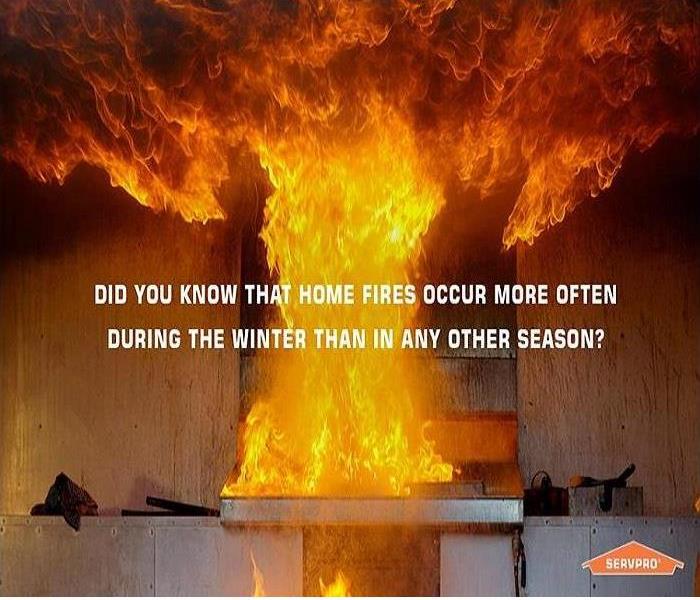 Practicing the best fire safety is how you can be most prepared for unexpected disaster in the winter.
Practicing the best fire safety is how you can be most prepared for unexpected disaster in the winter.
The winter season is just around the corner which means that home fires occur more often by unattended candles, space heaters, wood stoves and fireplaces.
At SERVPRO of S. San Rafael/Sausalito, we want to remind everyone to take simple steps to protect their homes and family from the danger of household hazards and heating equipment. Practicing the best fire safety is how you can be most prepared for unexpected disaster in the winter.
Here are some fire safety tips to prevent most heating related fires from happening:
- Keep anything that can burn at least three feet away from heating equipment, like the furnace, fireplace, wood stove, or portable space heater.
- Have your chimneys and vents checked. If you light fires frequently, you need a chimney sweep service once a year.
- Make sure the fireplace has a sturdy screen to stop sparks from flying into the room.
- Test smoke alarms. Make sure batteries are fresh. Place smoke alarms in the kitchen, laundry room and in bedrooms.
- Beware of lit candles. Candles can set the mood for relaxation, and that's how they get forgotten or knocked over by kids or pets.
- Beware of space heaters. Like fireplaces, people and pets should not be allowed to sit any closer than three feet.
- Don't put space heaters near curtains, tablecloths or other fluttering fabrics.
- Make sure the space heaters you buy have automatic shut-offs before reaching dangerous temperatures.
If you have the unfortunate experience of fire or smoke damage in your home or business call SERVPRO of S. San Rafael/Sausalito!
We are available 24 hours a day and are always Here to Help! Have Questions? Call Us Today – (415) 479-2900
What to Do and Don't Do After a Fire
11/1/2016 (Permalink)
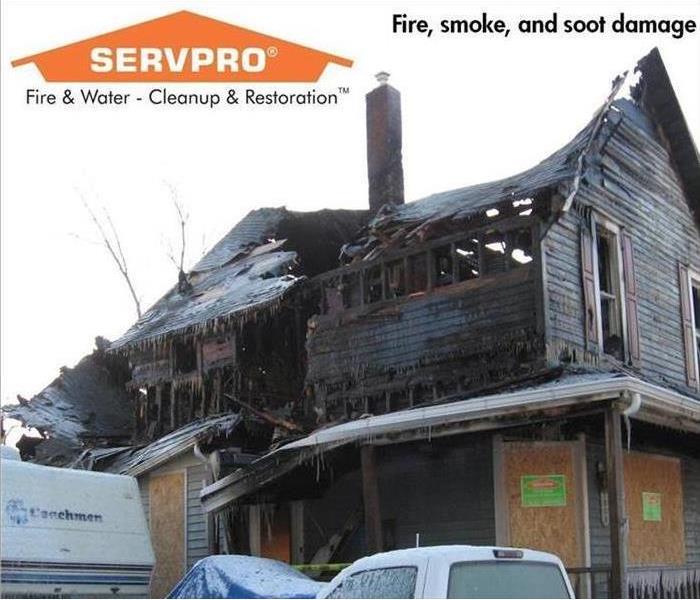 SERVPRO of S.San Rafael/Sausalito have specialized fire and smoke damage restoration training and experience to quickly clean up & restore your home.
SERVPRO of S.San Rafael/Sausalito have specialized fire and smoke damage restoration training and experience to quickly clean up & restore your home.
What You Can Do Until Help Arrives
The most important thing is to understand the risk to your safety and health even after the fire is out. The soot and dirty water left behind may contain things that could make you sick.
Here's What to Do and Don't Do After a Fire.
DO:
- Limit movement in the home to prevent soot particles from being embedded into upholstery and carpets.
- Keep hands clean so as not to further soil upholstery, walls and woodwork.
- Place clean towels or old linens on rugs, upholstery and carpet traffic areas.
- If electricity is off, empty freezer and refrigerator and prop doors open.
- Clean and protect chrome with light coating of petroleum jelly or oil.
- Wash houseplants on both sides of leaves.
- Change HVAC filter.
- Tape double layers of cheesecloth over air registers
DON'T:
- Attempt to wash any walls or painted surfaces without first contacting your SERVPRO Franchise Professionals.
- Attempt to shampoo carpet or upholstered furniture without first consulting your SERVPRO Franchise Professionals.
- Attempt to clean any electrical appliances (TV, sets, radios, etc.) that may have been close to fire, heat or water without first consulting an authorized repair services.
- Consume any food or beverages that may have been stored close to fire, heat or water. They may be contaminated.
- Turn on ceiling fixtures if ceiling is wet. The wiring may be wet or damaged and can cause electrical shock.
- Send garments to the dry cleaner. Improper cleaning may set in smoke odor.
If your home or business has been damaged by the fire, you may not know where to turn. SERVPRO of S. San Rafael/Sausalito is here to help restore your property to preloss condition and make it, "Like it never even happened!" We are available 24 hours a day and can have a team of technicians out to your property in no time!
Have Questions? Call Us Today – (415) 479-2900
Safety Tips in Case of a Fire at Home
11/1/2016 (Permalink)
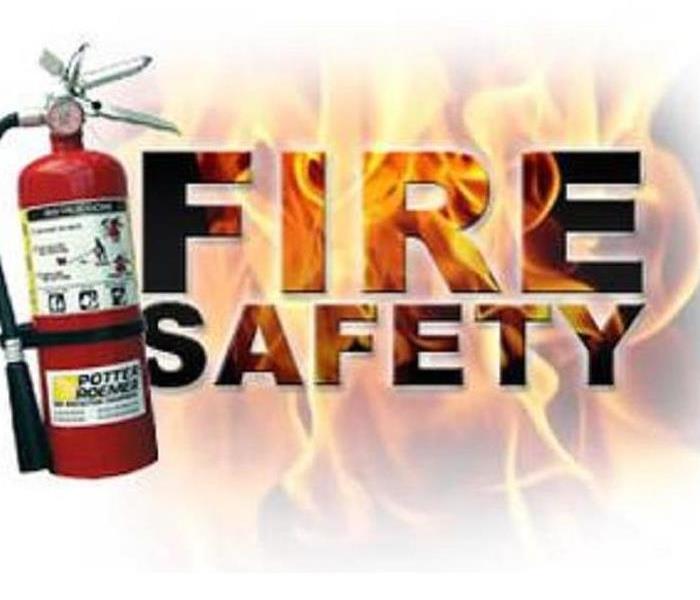 Important fire safety tips to help you and your family in case of a fire at home.
Important fire safety tips to help you and your family in case of a fire at home.
Important and useful safety tips in case of a fire at home
In case of a fire at your home, your priority is to get yourself and your family members out as quickly as possible. There is no time to gather valuables. Fire can spread out within seconds and in just a few minutes, it can become life-threatening.
Don't attempt to extinguish any fire if there is a threat to your safety. If you're unable to exit your home safely because of smoke or fire, remain in your room until it is safe to do so. Keep door closed and await assistance from the fire department.
After the fire trucks leave, your home likely suffers from fire, smoke damage and extensive water damage from firefighting efforts. At SERVPRO of S. San Rafael/Sausalito, we have the specific damage restoration training, personnel, and equipment and can quickly restore your home to pre-fire condition.
Have Questions about Fire, Smoke, or Soot Damage?
Give us a call at 415-479-2900.
Common Causes of Kitchen Fires
11/1/2016 (Permalink)
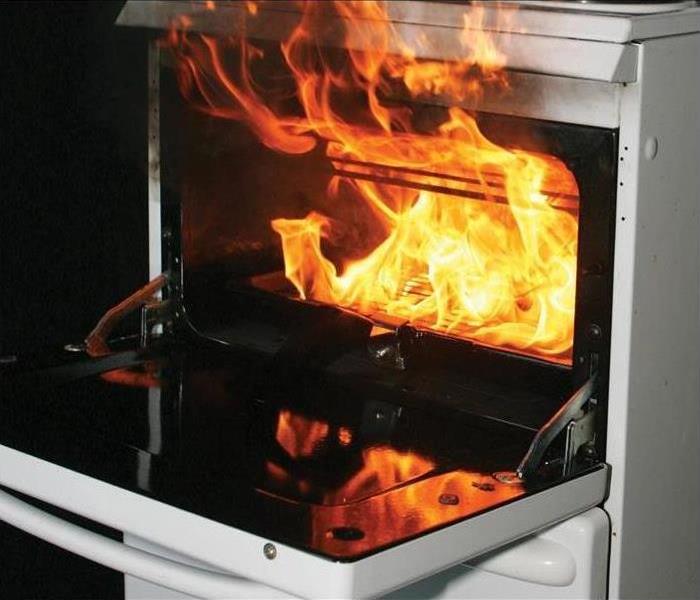 When a fire starts inside your oven, keep the door closed and turn it off immediately. The lack of oxygen will suffocate the flames.
When a fire starts inside your oven, keep the door closed and turn it off immediately. The lack of oxygen will suffocate the flames.
The kitchen is the source of many fire hazards because it's where heat, electricity, water and grease come together. The most common type of fire is the grease fire. A grease fire is extremely dangerous as it can get out of control quickly and spread from the stove throughout the kitchen and into other rooms of the house.
Common Causes of Kitchen Fires
- Too high temperature in the fryer
- Vegetable, more flammable, oils
- Old, more flammable oil, in the deep fryer
- Fat deposits in the flue and ventilation ducts
- Misalignment sprinklers due to equipment moved around
- Clogged melting links of the sprinklers leading to impaired function
Other types of kitchen fires include oven fire or the microwave. When a fire starts, keep the door closed and turn off the oven. The lack of oxygen will suffocate the flames. If continues to smoke like a fire use a fire extinguisher or call fire department.
At SERVPRO of S. San Rafael/Sausalito we are available 24 hours and 7 days a week. Give us a call at 415-479-2900. We can help make any damage you are facing, "Like it never even happened!"
Prepare for a fire emergency
7/7/2016 (Permalink)
 Servpro of S. San Rafael/Sausalito
(415) 479-2900
Servpro of S. San Rafael/Sausalito
(415) 479-2900
SERVPRO of S. San Rafael/Sausalito knows the first 48 hours after a fire can make the difference between restoring versus replacing your property. We want to make your damages “Like it never even happened” and get your home or business up and running again.
It is important to know who to call when an emergency happens because you never know when disaster will strike! One of the most common causes of fires is cooking equipment, followed by heating equipment, being aware and prepared for emergency situations can be the difference in saving and salvaging your property. Make sure to have smoke alarms up in each room and check them regularly to ensure they’re properly working.
We are a 24-Hour Emergency Service that can respond immediately to your emergency with the expertise to handle your restoration or cleaning needs!
Give us a call at (415) 479-2900
Fire Safety
6/3/2016 (Permalink)
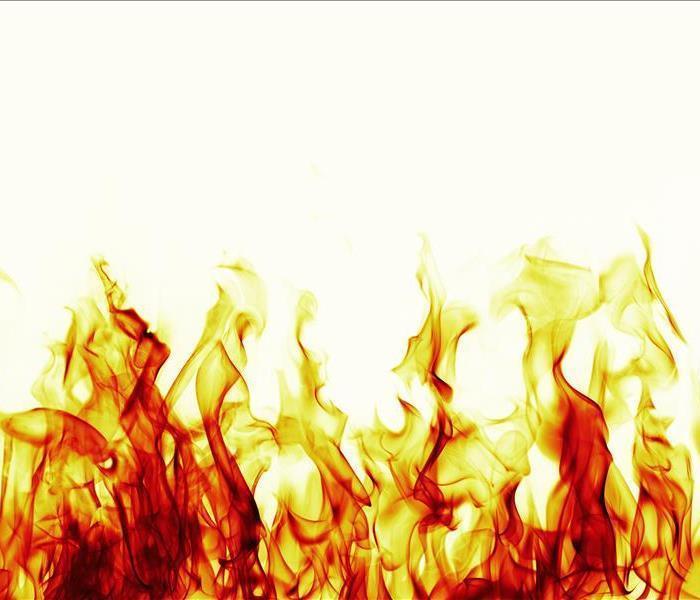 Servpro of S. San Rafael/Sausalito
415-479-2900
Servpro of S. San Rafael/Sausalito
415-479-2900
Its time to Fire up your grill! Not your home.
With the heat of summer just begining we at SERVPRO of S. San Rafael/Sausalito are thinking about bbq's and relaxing weekends like the rest of you.
Summer means fun under the sun and for us here in Northern California, you might beat the Beach, at the Russian River, or at home with your grill. Your local SERVPRO wants to remind you to be safe with your grills!
At SERVPRO of S. San rafael/Sausalito we can handle any size Fire, Smoke, Water damage you may incounter. But that doesnt mean we want you to have to call us for sudden fire or smoke damage.
Be safe with your grill or bon fires, and remember your local SERVPRO is always Here to Help if you need it!
Contact our 24/7 line at 415-479-2900 ANY TIME!
Fire or smoke damages
4/1/2016 (Permalink)
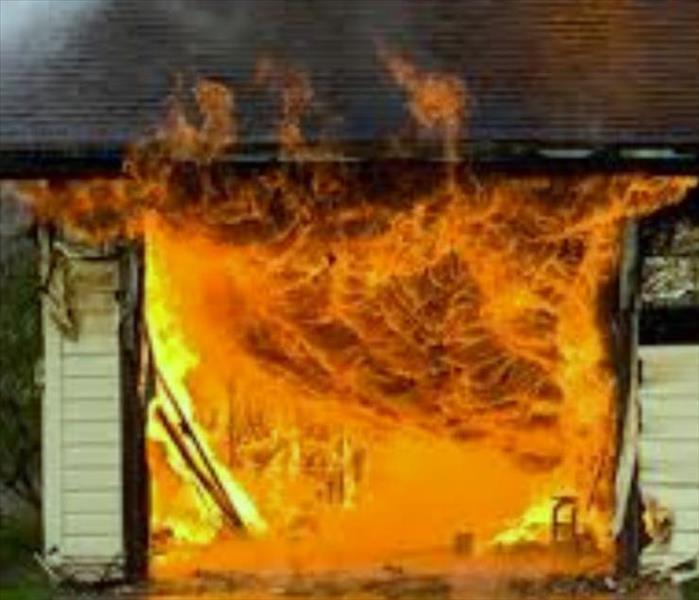 CALL SERVPRO OF S SAN RAFAEL/SAUSALITO
415-479-2900
CALL SERVPRO OF S SAN RAFAEL/SAUSALITO
415-479-2900
If you have the unfortunate experience of fire or smoke damage in your home or business call SERVPRO of S.San Rafael/Sausalito with any questions or concerns! We are available 24hours a day and can have a team of technicians out to your property in no time!
Winter happens to be the most common time of the year for fires in a residence, and having smoke from a fire can be just as damaging as a pot left on a hot stove. Make sure you are taking preventative measure in your home or business!
If you have fire or smoke damages to your property give SERVPRO of S. San Rafael/Sausalito a call and we can answer any questions you have. We are specialists on Fire, Water, Smoke, and Mold damages, you can rely on us to help restore your property.
Call SERVPRO of S. San Rafael/Sausalito today! 415-479-2900
SERVPRO can handle your Fire Damages
1/13/2016 (Permalink)
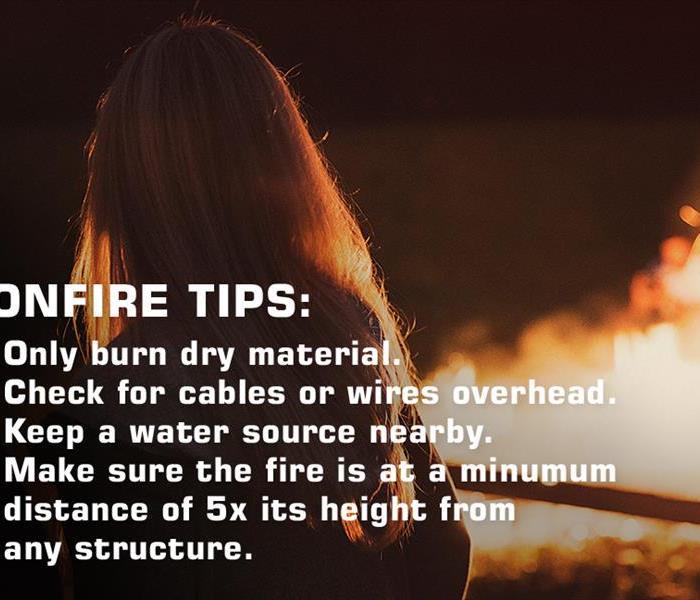 Servpro of South San Rafael/ Sausalito is always here to help
Servpro of South San Rafael/ Sausalito is always here to help
At SERVPRO of S. San Rafael/Sausalito franchise professionals can take care of your fire damage. By providing timely response with our services, ranging from FIRE, SMOKE, and SOOT removal, to contents claims inventory, and document restoration, and so much more. At SERVPRO of S. San rafael/Sausalito we know the first 48 hours after a fire can make the difference between restoring versus replacing your property. We are always faster to any size disaster and will strive to make your damages "Like it never even happened" always.
We are available 24-hours a day, 365 days a year!
If you have Fire Damage, or any questions call 415-479-2900 now!
Fire or Water Damage! We can handle it!
11/18/2015 (Permalink)
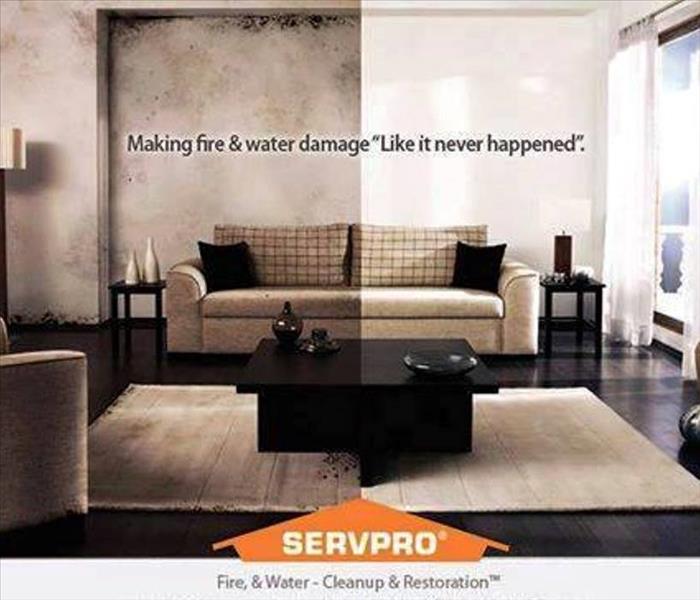 "Like it never even happened"
"Like it never even happened"
At SERVPRO of S. San Rafael/Sausalito provides 24-hour emergency service and is dedicated to being faster to any-sized disaster in S. San Rafael/Sausalito and surrounding cities! We can respond immediately to your emergency and have the expertise to handle your restoration or cleaning needs.
- 24-Hour Emergency Service
- Faster to Any-Sized Disaster
- Highly Trained Restoration Technicians
- A Trusted Leader in the Restoration Industry
- Locally Owned and Operated
- Advanced Restoration and Cleaning Equipment
Have Questions? Call Us Today – (415) 479-2900
Residential Services
Whether your San Rafael/Sausalito home needs emergency Fire Damage, Flood Damage or your upholstery cleaned, you can depend on us. Our technicians have extensive cleaning and restoration training and can make your property look its best. Learn more about our residential services:
- Water Damage Restoration
- Fire Damage Restoration
- Mold Remediation
- Storm Damage Restoration
- Cleaning Services
- Building/Reconstruction Services
Commercial Services
There's never a convenient time for fire or Water damage to strike your San Rafael/Sausalito commercial property. Every hour spent cleaning up is an hour of lost revenue and productivity. So when the need arises for fast professional cleaning or emergency restoration services we has the training and expertise to respond promptly with highly trained technicians to get your property back to business. Learn more about our commercial services:
- Commercial Water Damage Restoration
- Commercial Fire Damage Restoration
Planning for a fire
5/26/2015 (Permalink)
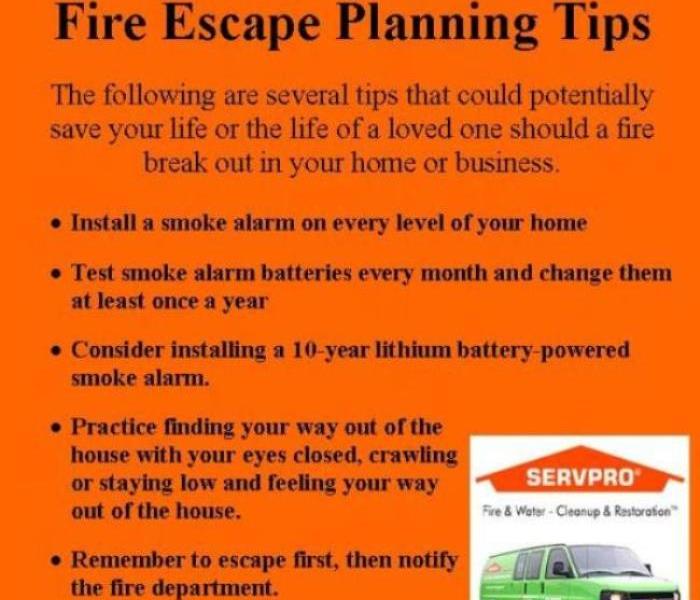 Tips
Tips
Always be prepared! Know what to do in case there is a fire and have a plan in place.






 24/7 Emergency Service
24/7 Emergency Service


